Hat Yai Municipal Park is a must-visit for anyone coming to Hat Yai, but here’s the catch: it can be tricky to fully enjoy without your own transportation. Why, you ask? Because if you’re relying on community songthaews to get there and back, their schedule is not necessarily going to match yours. In fact, I’d suggest skipping that option altogether unless your timing is perfect and you just happen to catch one heading in the direction you want to go. Really.
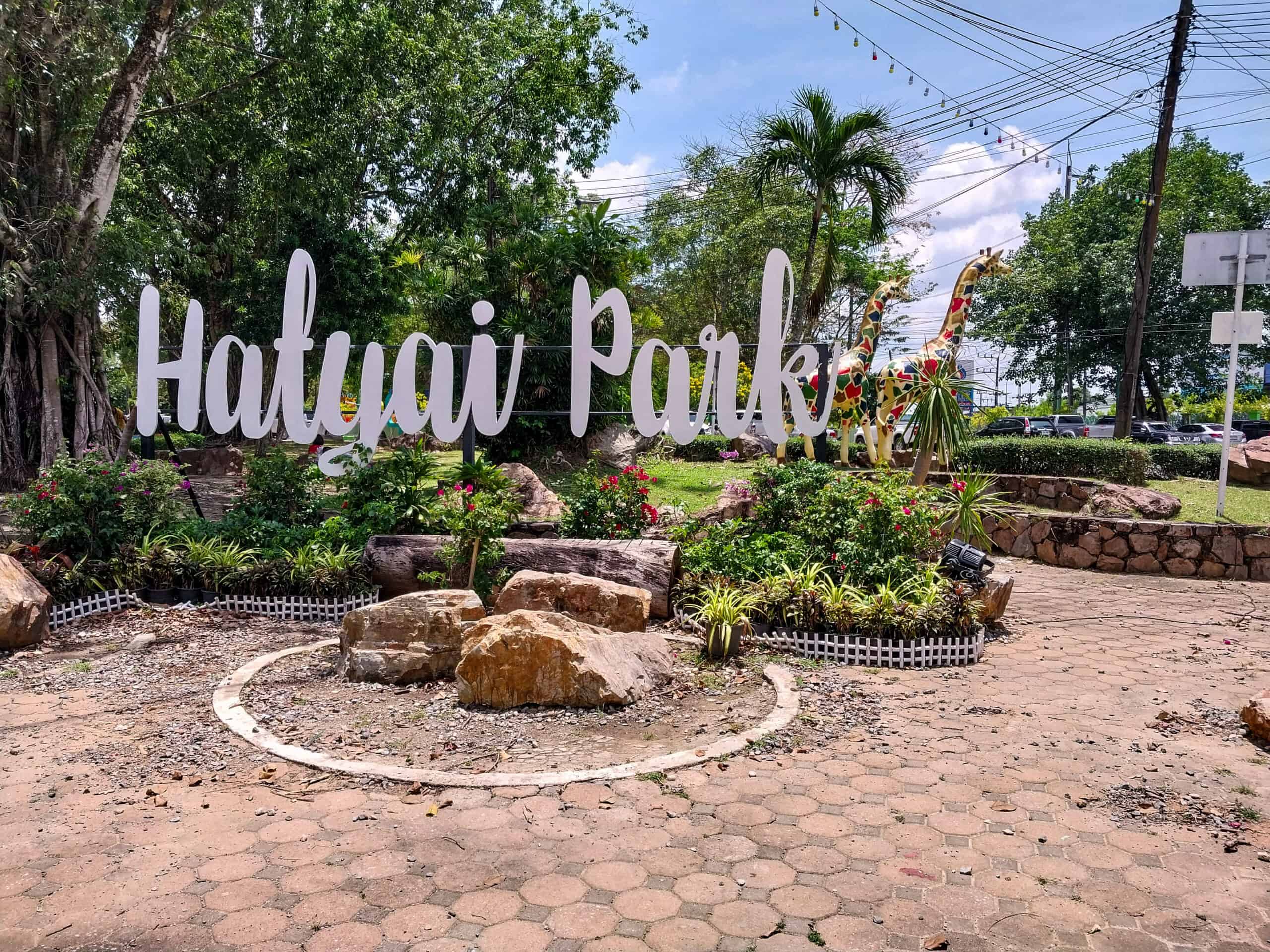
That said, if this is your first visit to Hat Yai Municipal Park, and maybe the only chance you’ll have (especially if you don’t speak Thai or have your own transport), here’s what I recommend. This is where GRAB is your best Hat Yai friend. Thankfully, Hat Yai now has plenty of Grab taxis, which means no more exhausting hand-waving or mysterious fare negotiations. I’ll get back to transportation tips in a bit. But trust me, this park is fascinating and worth spending more than an hour at.
Location & History of Hat Yai Municipal Park
Hat Yai Municipal Park is located on Kanjanavanich Road about 6 kilometers from the Hat Yai city center. The 355-acre park was opened as a recreational and cultural space that highlights the history and diversity of Thailand through its statues, religious icons, and nature, and, according to some sources, to honor the birthday of King Bhumibol Adulyadej (Rama IX).
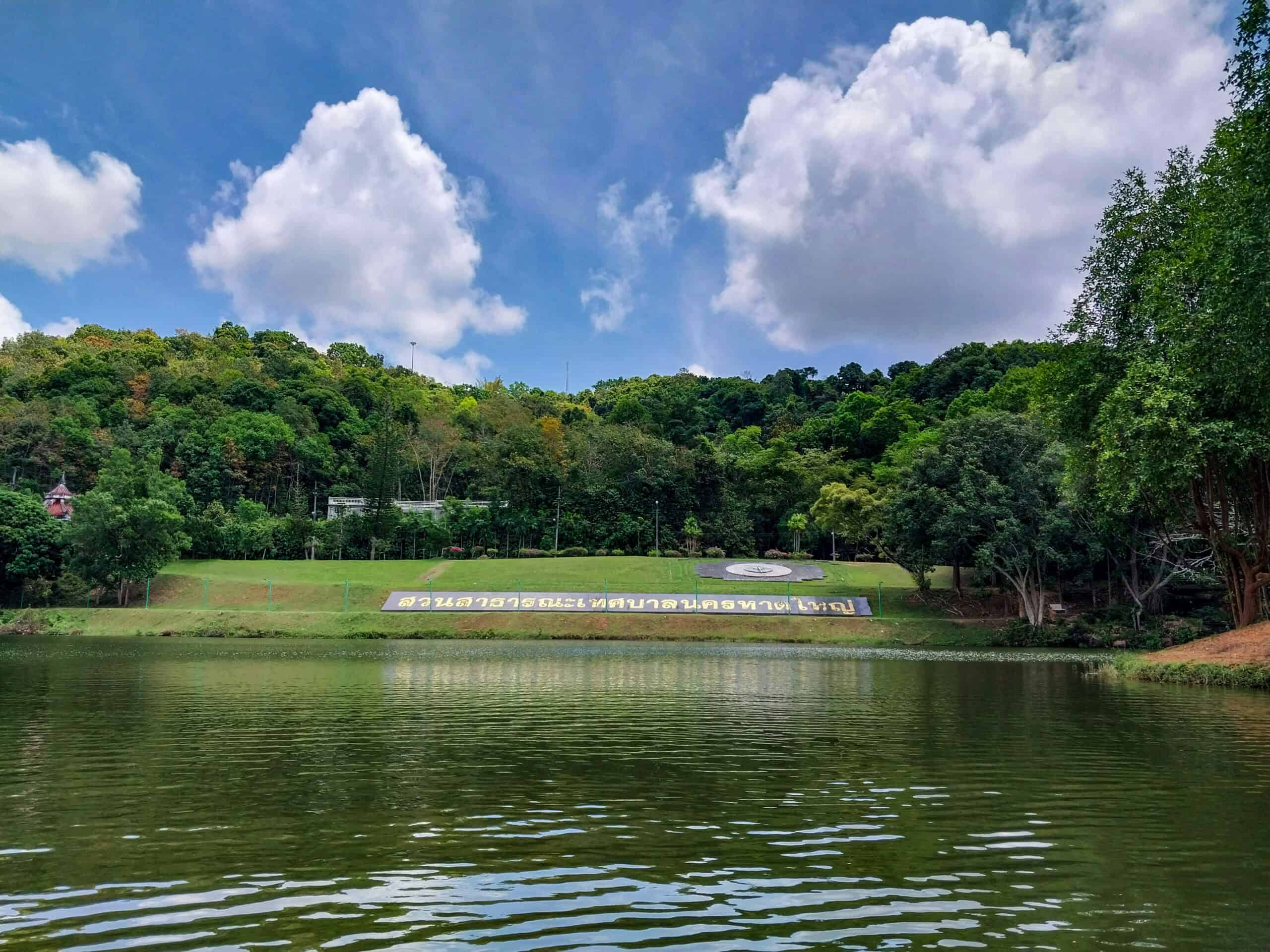
The park is filled with an eclectic collection of statues that are colorful and interesting to look at. Not to mention very Instagram-worthy. But despite their artsy presentation, they all (mostly) represent Buddhism; Phra Phuttha Mongkol Maharat, Hinduism; Thao Maha Phrom Shrine (Four-Faced Brahma Shrine), Taoism; Jade Emperor Shrine, and Chinese Folk Religion; Guan Yin (Goddess of Mercy). Thus, should be engaged with in a respectful manner. Visitors should also be mindful of worshipers when taking photos.
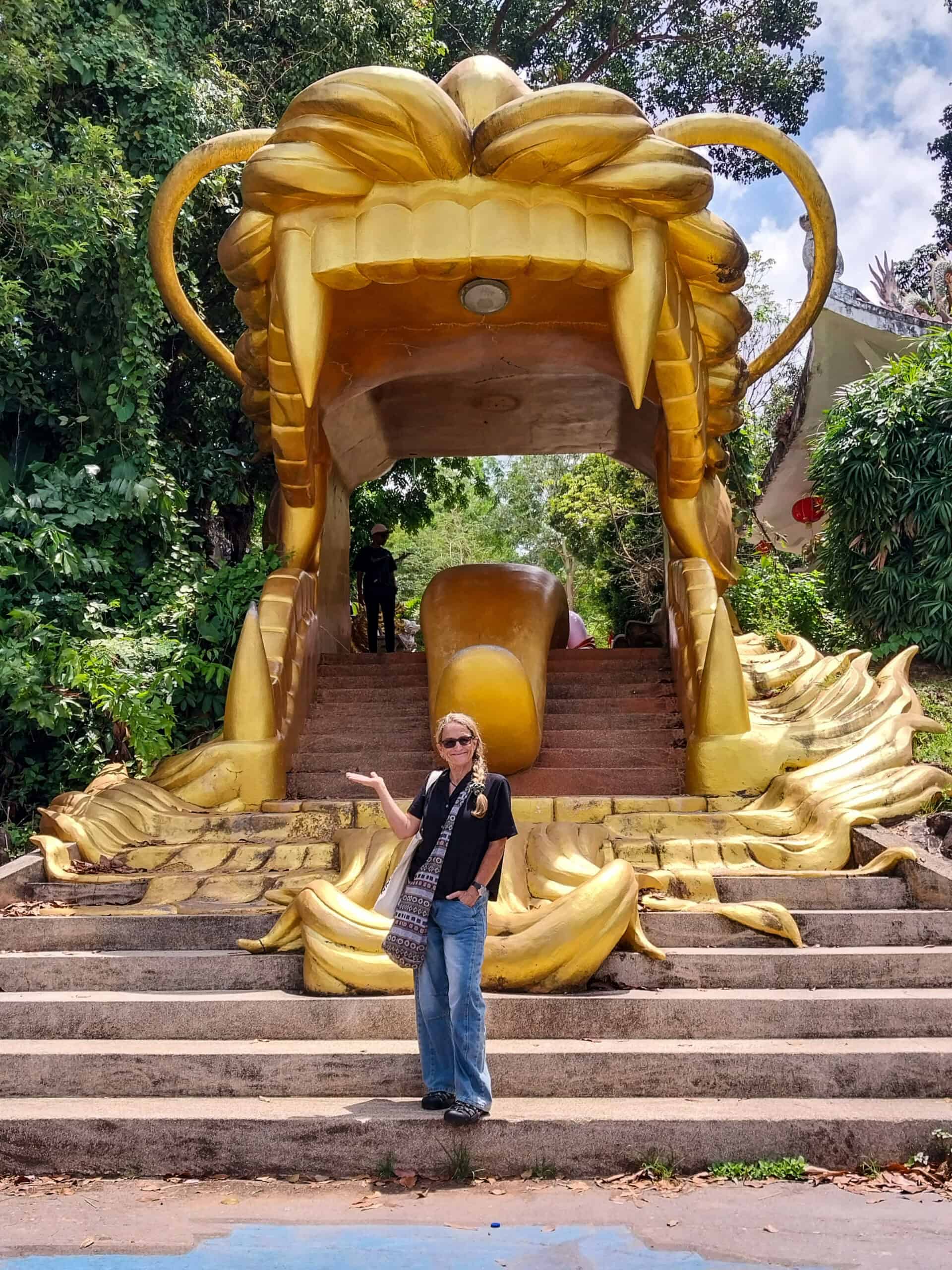
What’s There to Do in Hat Yai Park? A lot!
Hat Yai Municipal Park spreads across Khao Kho Hong Mountain, which has an elevation of 387 meters (1,270 feet) and about 322 meters (1,056 feet) above the surrounding land. The park’s layout can be confusing at first glance because there are two main hilltops, a mid-slope area, and an expansive lower section. But once you understand the geography, it’s easy to explore most (if not all) of the main highlights in a single visit.
Hat Yai Municipal Park Mini Map
If you’ve got your heart set on riding the cable car, you’ll want to start your park exploration at the Khao Kho Hong (also known as Golden Buddha Hill). But make sure the cable car is open that day. If it’s not, you’ll want to start at Thao Maha Phrom Hill (Brahma Shrine Peak), because it’s much easier to walk downhill than to backtrack uphill on foot.
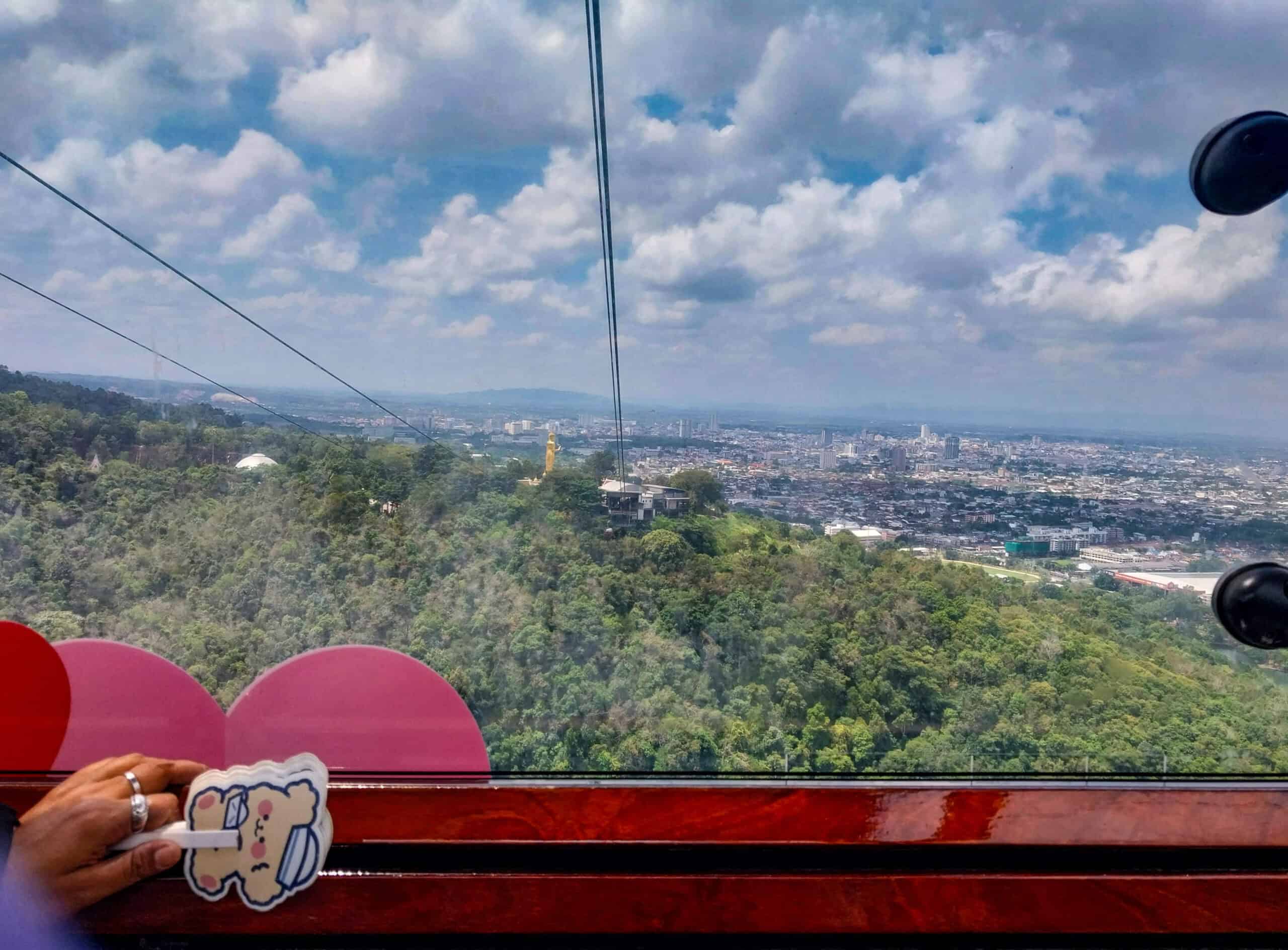
Beyond the round-trip cable car ride, the only other options for getting from one hilltop to the other are the main road or a steep set of stairs. A sweaty start to a sightseeing day is never a good idea, trust me on that.
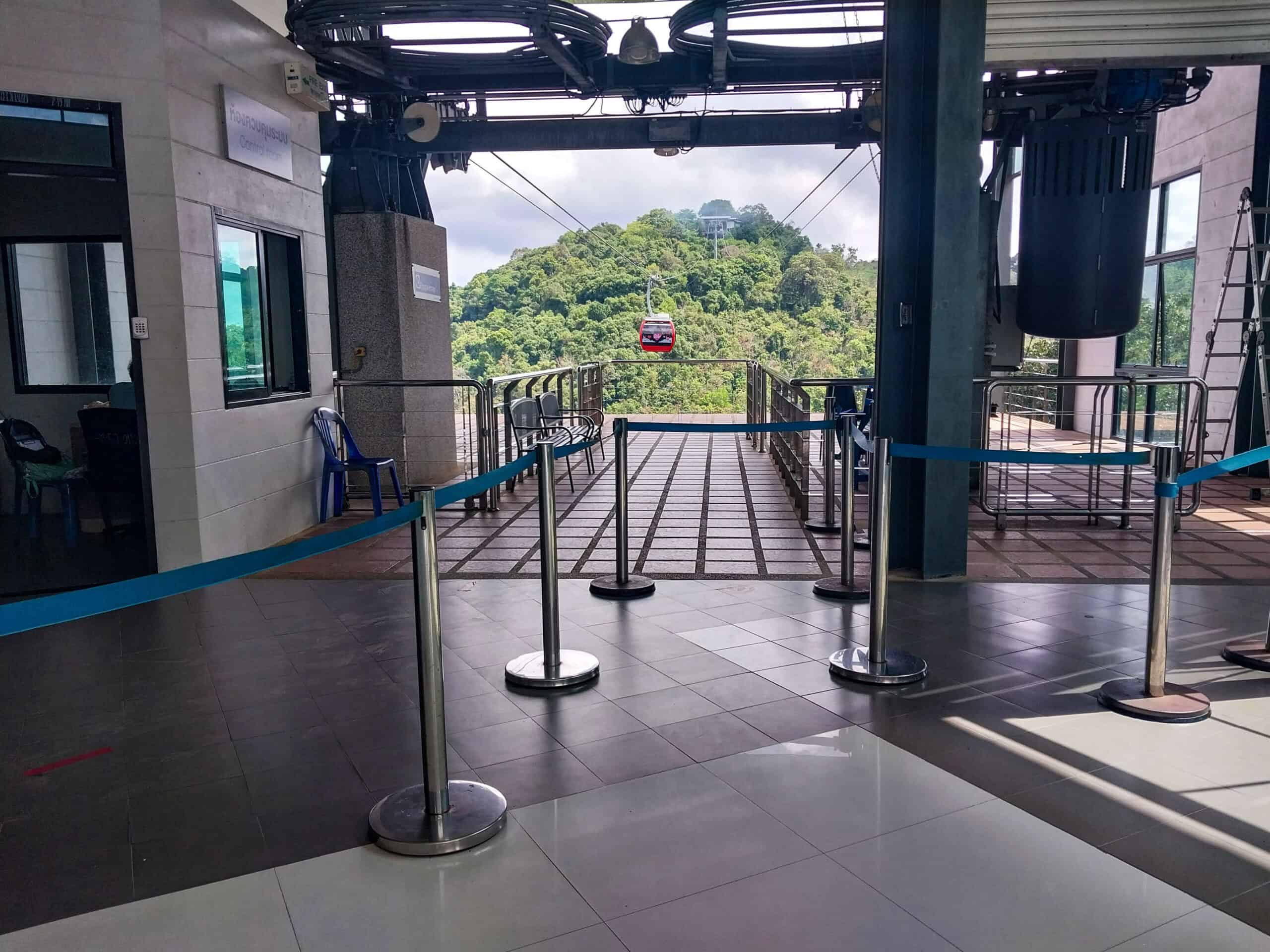
First Stop: Khao Kho Hong (Golden Buddha Hill)
Khao Kho Hong is the main peak of Hat Yai Park and is often referred to as Golden Buddha Hill. This is the highest point in the park and truly the star of the show. It’s also a popular stop for tour buses. Not only does it offer amazing panoramas of Hat Yai, it’s also home to the Golden Standing Buddha (Phra Buddha Mongol Maharaj), one of the city’s most iconic landmarks.
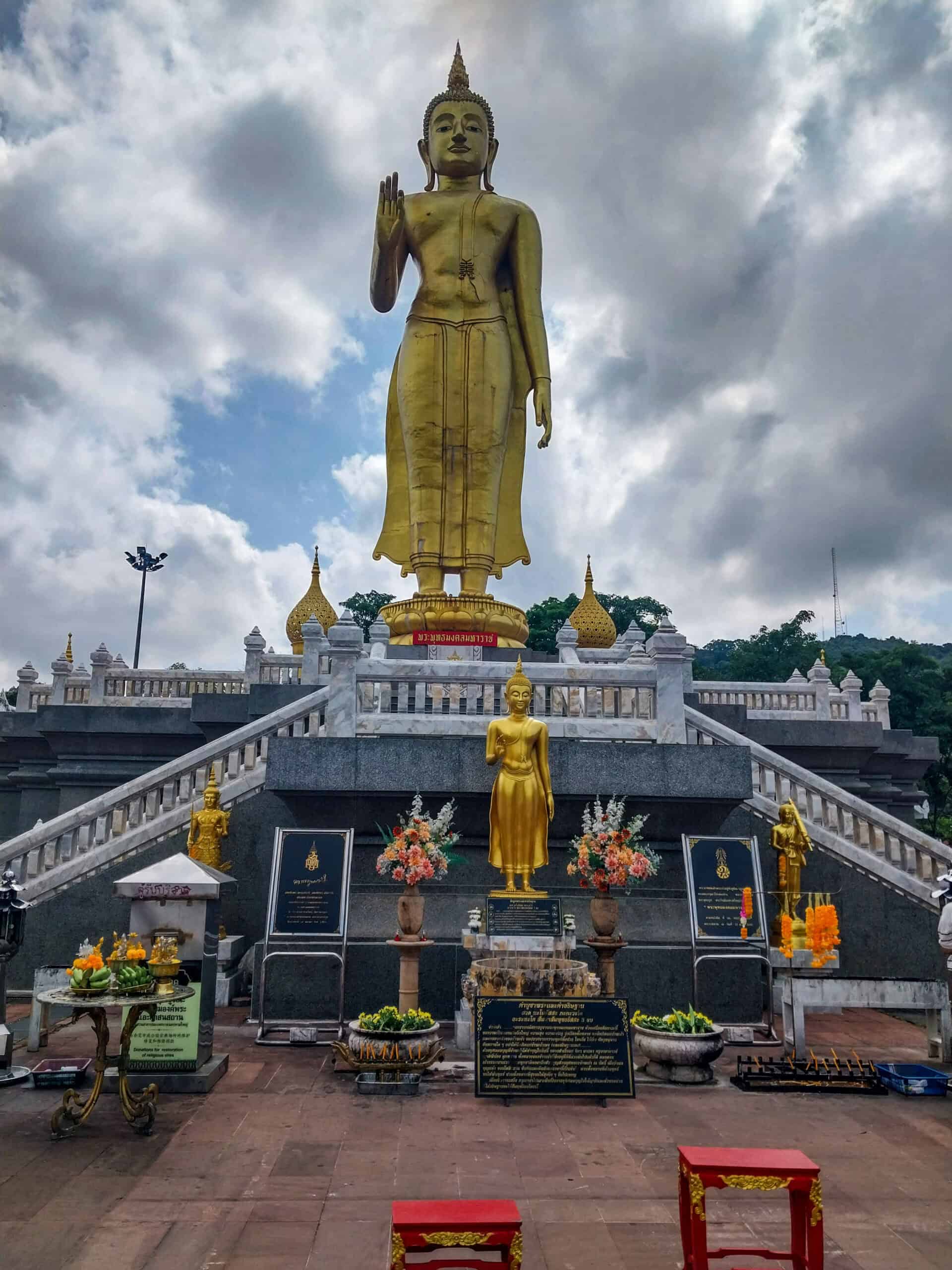
The Phra Buddha Mongkol Maharaj, known locally as the Golden Standing Buddha, was completed in 1999 and stands nearly 20 meters tall, weighing 200 tons. Standing Buddhas symbolize the Buddha rising to teach or to protect, with the pose representing moments of blessing, reassurance, and the act of offering protection, known as the Abhaya Mudra.
Inside the statue’s base, historic photos show its construction and precarious hilltop placement. It’s worth a look if the doors happen to be open (sometimes they’re locked).
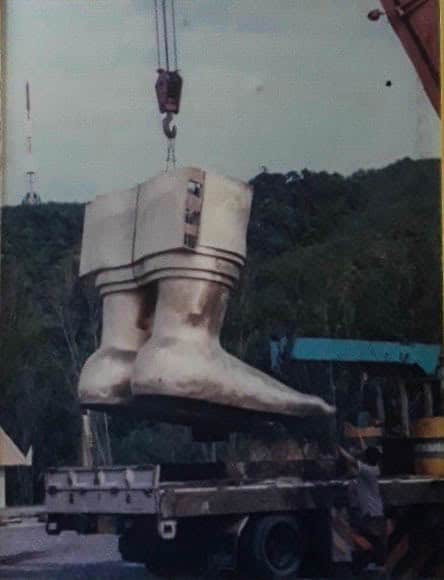
Just below and across from the Golden Standing Buddha is a scenic vantage point that draws crowds during the day as well as at sunset. The views of Hat Yai from here are incredible.
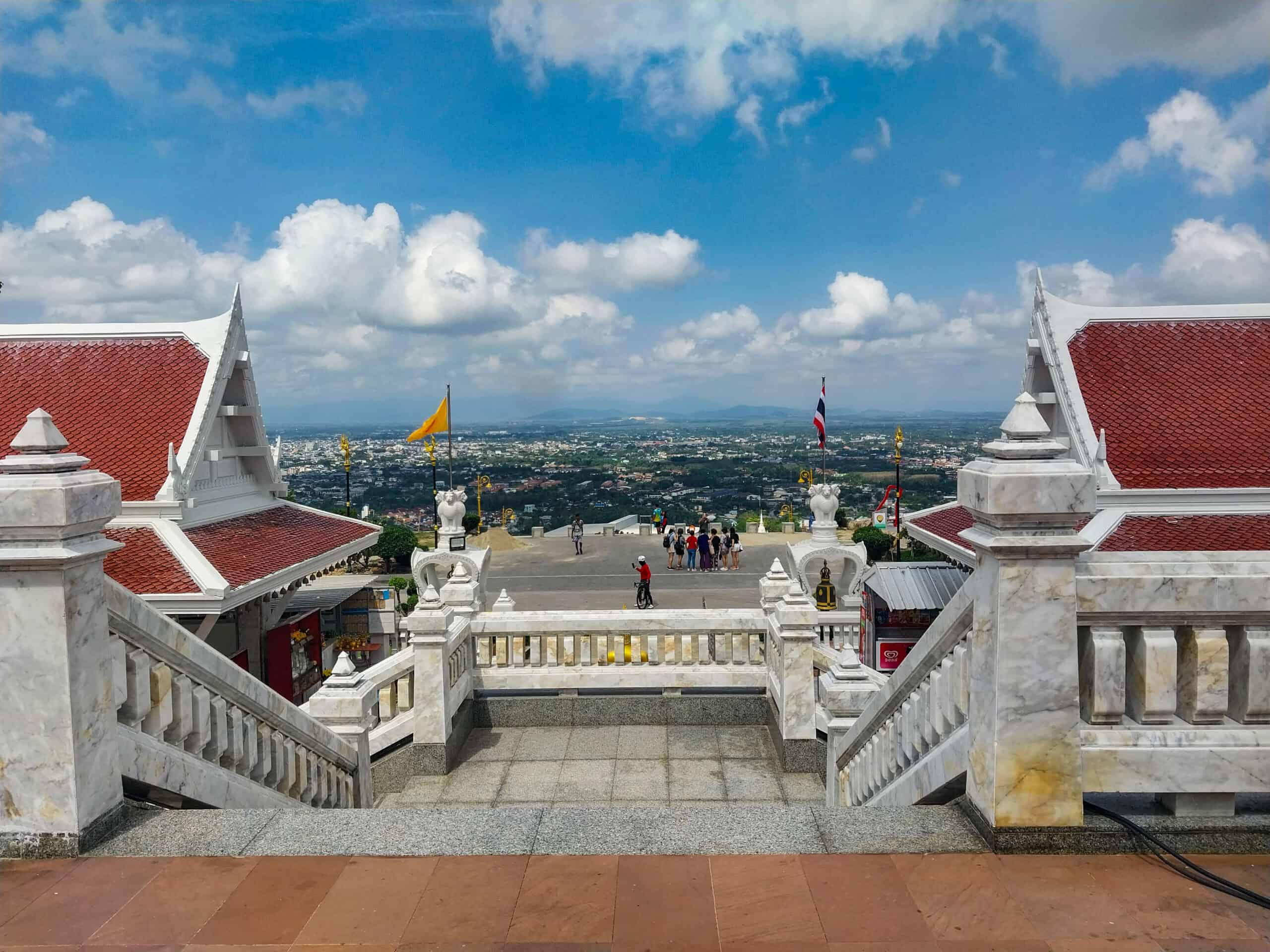
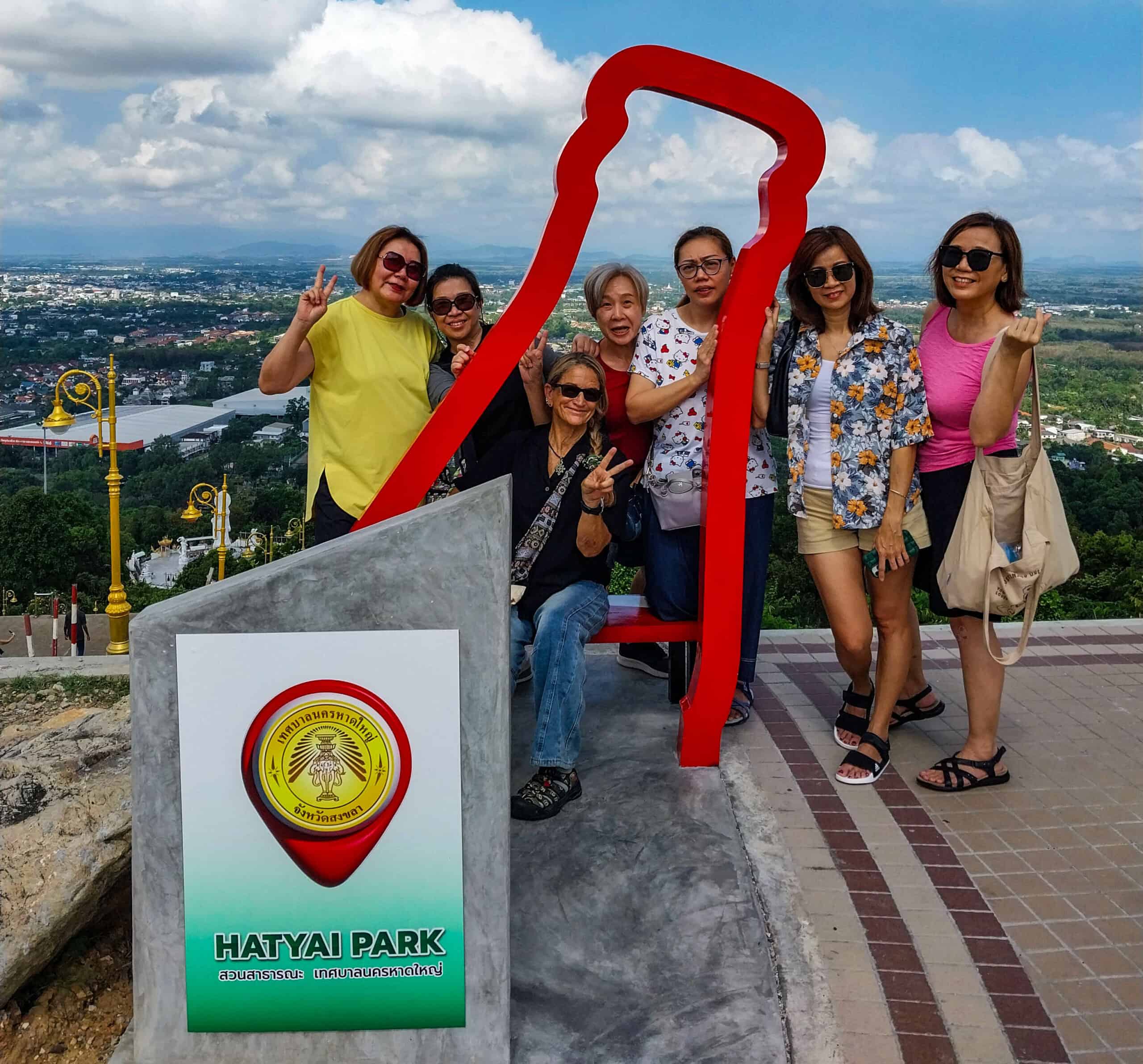
More to Explore Around Golden Buddha Hill
Also nearby, the Dragon Staircase leads visitors through the mouth of a dragon to a Laughing Buddha. From there, a steep set of stairs continues to a second, smaller mountain peak and Thao Maha Phrom Shrine (Four-Faced Brahma Shrine). This part of the climb can get a little sweaty, but the cable car offers a far more relaxing route.
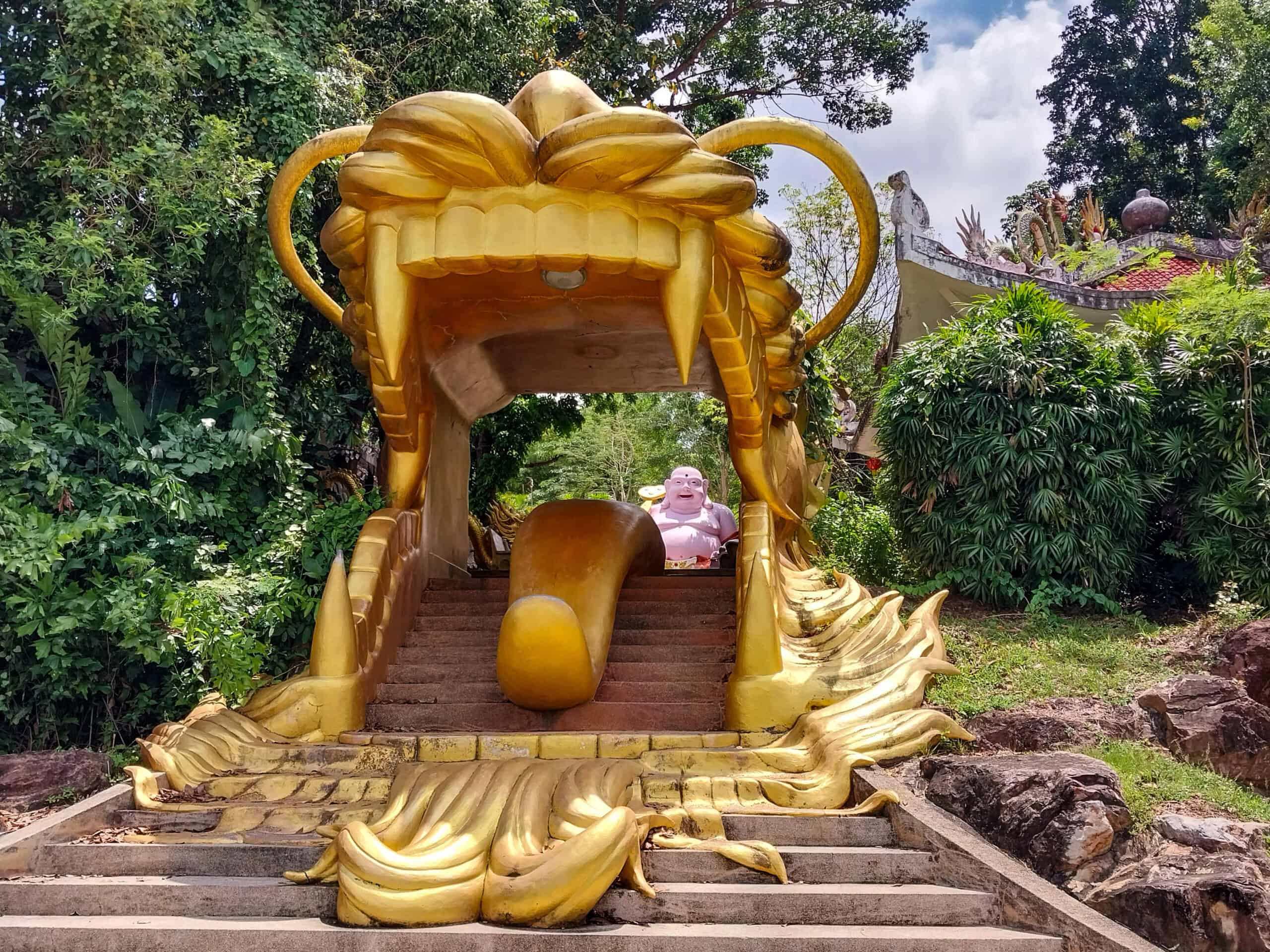
East of the Golden Standing Buddha is the Hat Yai Observatory (also known as Hat Yai Deepsky Observation for Science and Astronomy Center). The small facility was established as a learning center to promote astronomy and includes a planetarium dome, telescopes, and educational exhibits. The observatory is open Wednesday through Sunday, 8:00am until 4:30pm and the entry fee is just 20 baht per person.
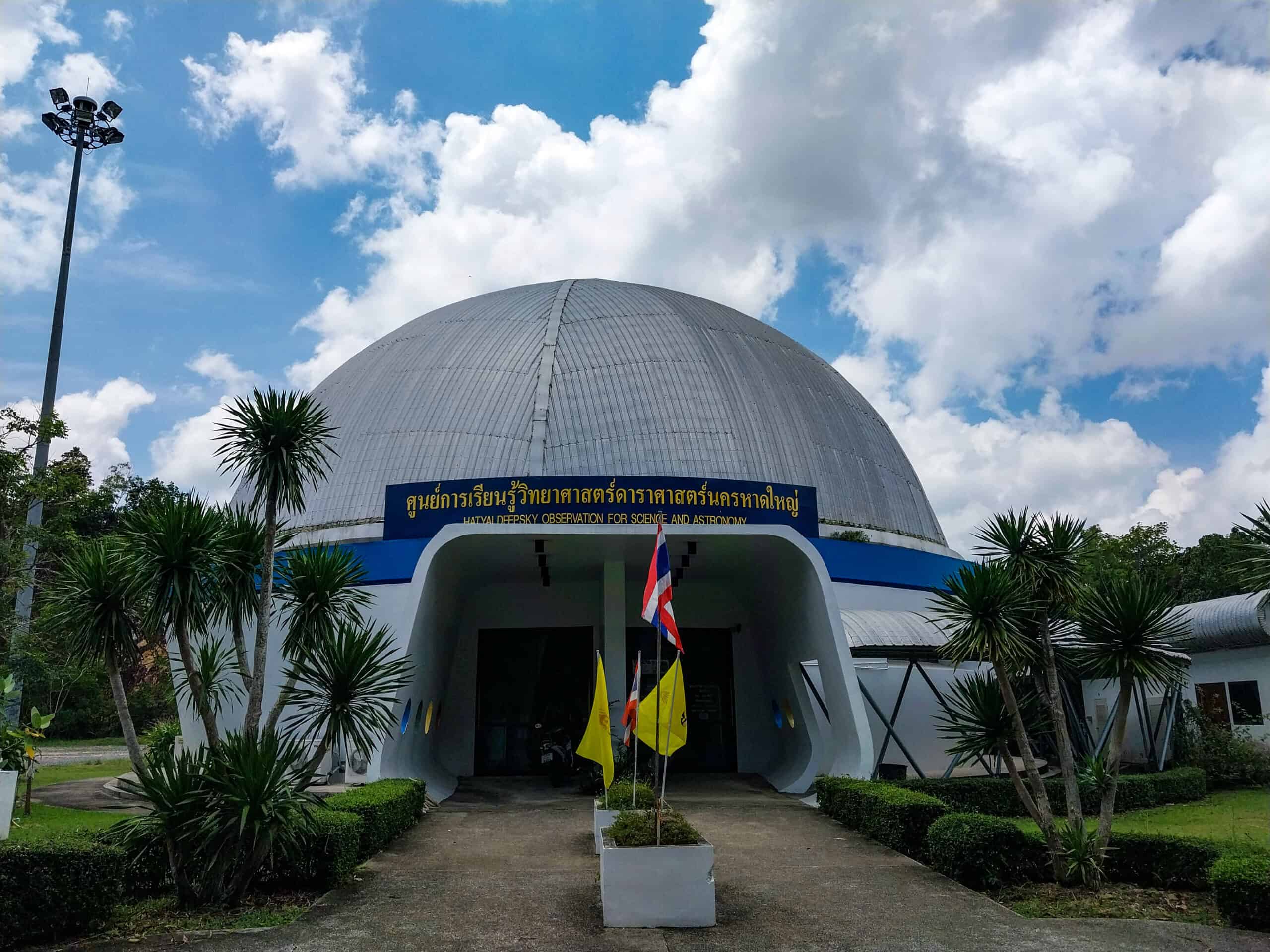
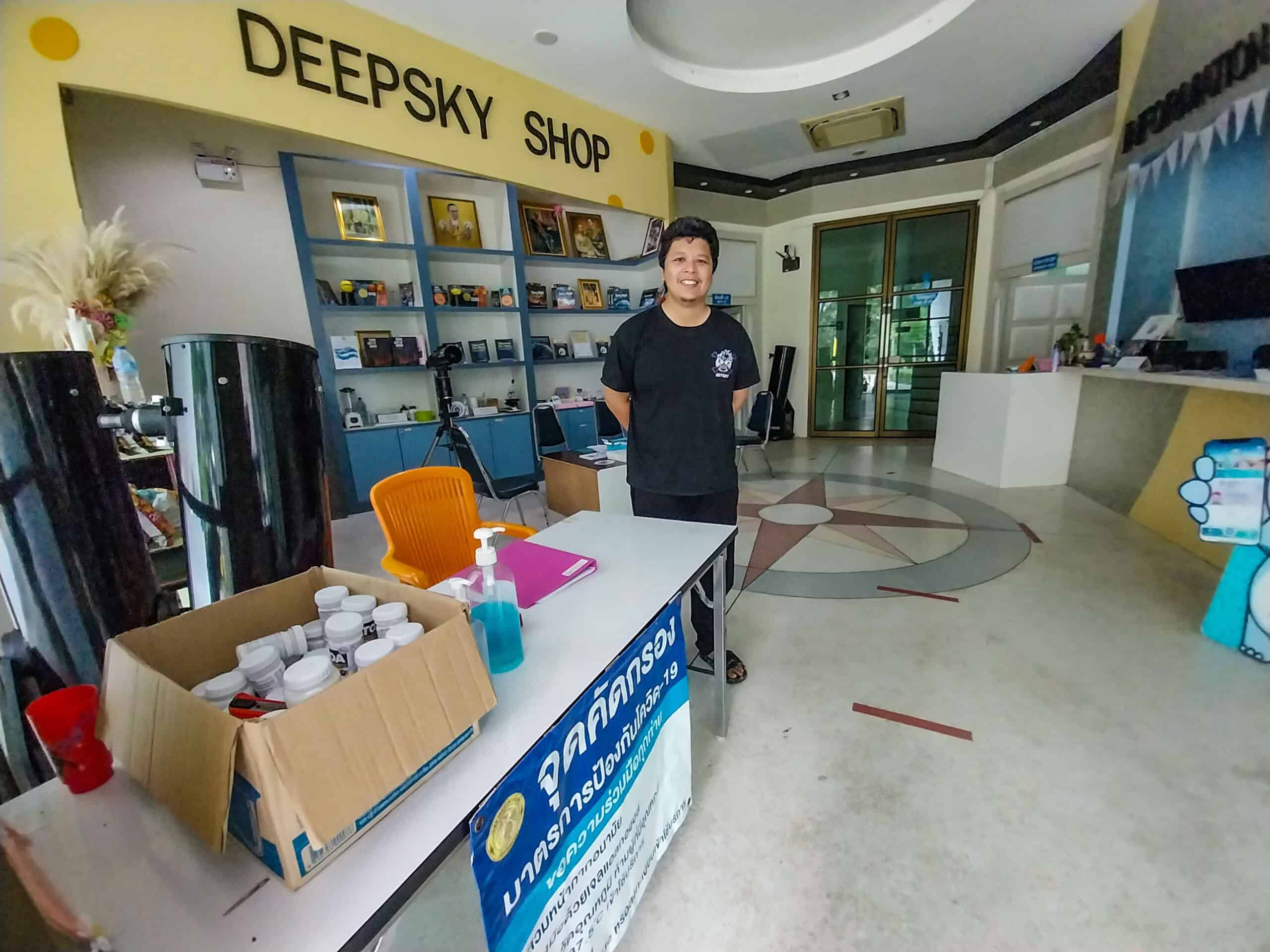
A short distance away is the striking Erawan Shrine, also known as the Three-Headed Elephant Shrine. The enormous statue represents the mythical Airavata from Hindu and Buddhist mythology and stands as a symbol of strength and wisdom. It’s also surrounded by a small herd of golden elephants and is a real eye-catcher.
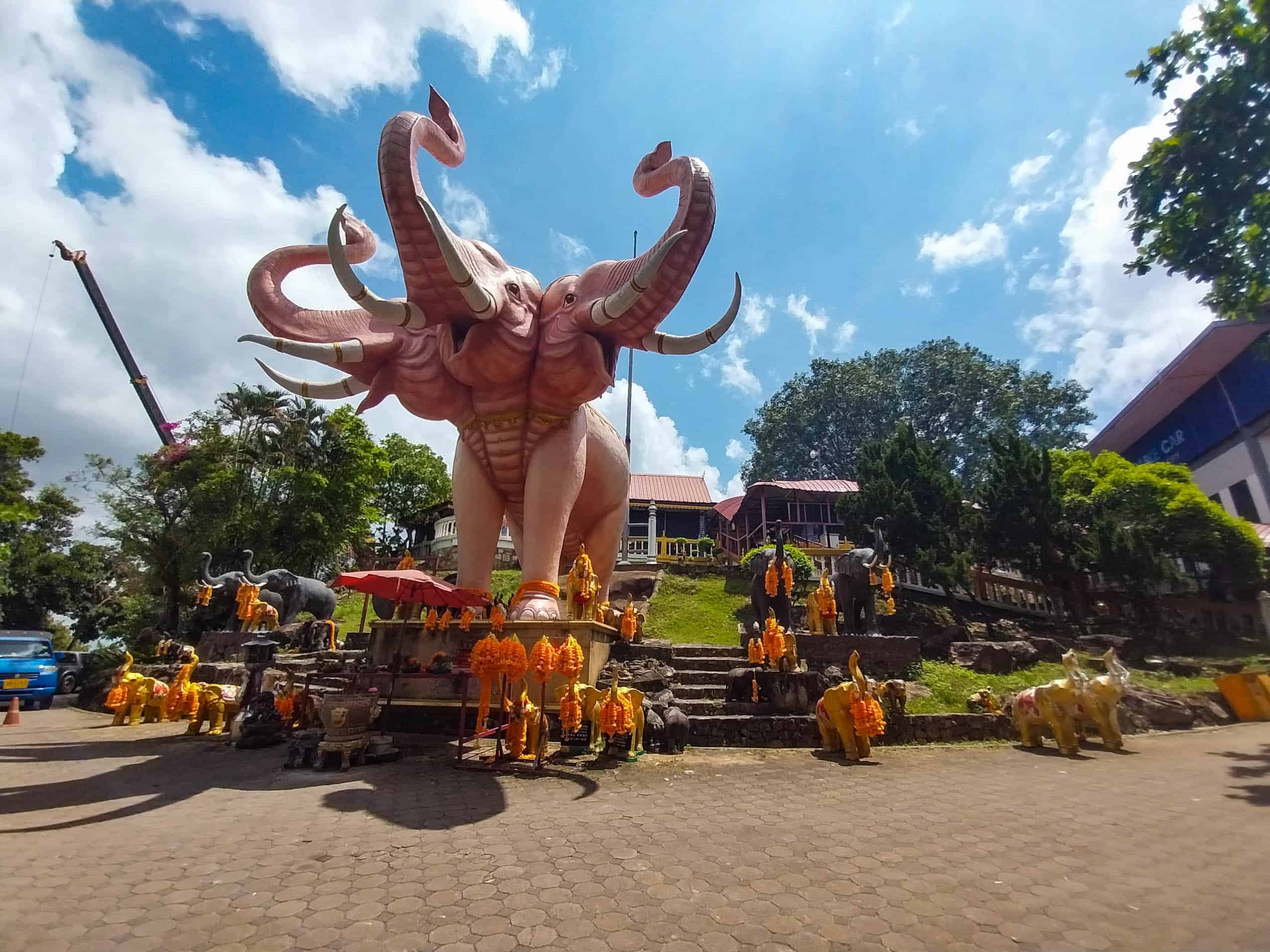
The main Hat Yai Cable Car ticket counter is located across the road from the Golden Buddha and Erawan Shrine and offers round-trip tickets from Khao Kho Hong to the Thao Maha Phrom Shrine on the opposite peak for just 200 baht. The views from the cable car are gorgeous and well worth the money. Be sure to keep your ticket, as the ‘round-trip’ option is not obvious. It’s usually open Tuesday through Sunday, from 9:00am until 4:00pm.
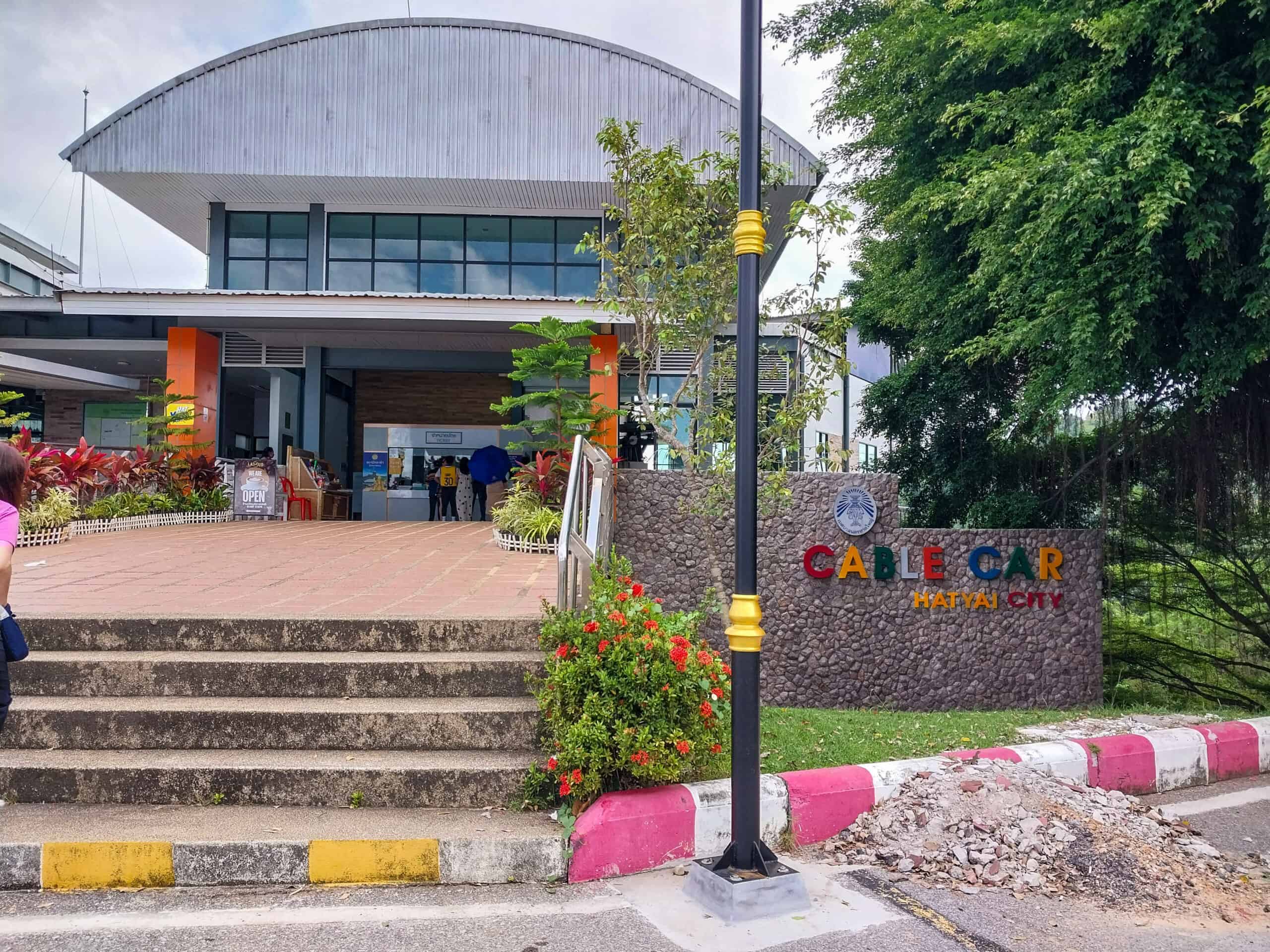
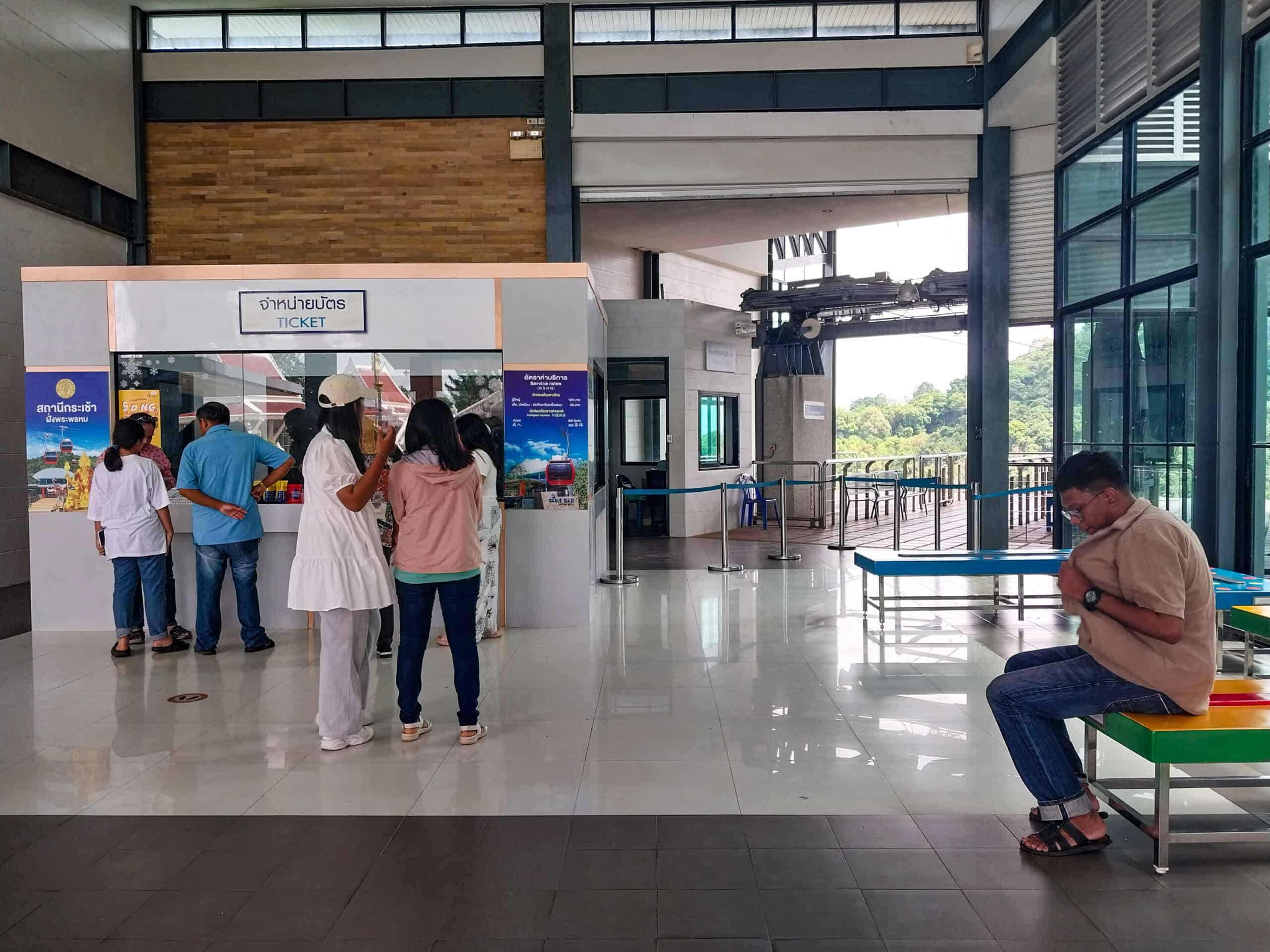
In addition to the touristy ambiance of the Golden Buddha area, there are souvenirs and snacks available as well as benches to just hang out and enjoy the scenic views. Do note that if you are on a tour (or waiting for a songthaew) you will have limited time to “hang out” anywhere, thus the advantage of exploring Hat Yai Municipal Park on your own.
Best Starting Point: Thao Maha Phrom Hill (Brahma Shrine Peak)
Across a small valley from Golden Buddha Hill is a second hill; Thao Maha Phrom Hill, home to the Thao Maha Phrom Shrine (Four-Faced Brahma Shrine). It’s conveniently reachable by the Hat Yai Cable Car, or alternatively by the sweat-inducing stairway or the lengthy service road that winds up the slope.
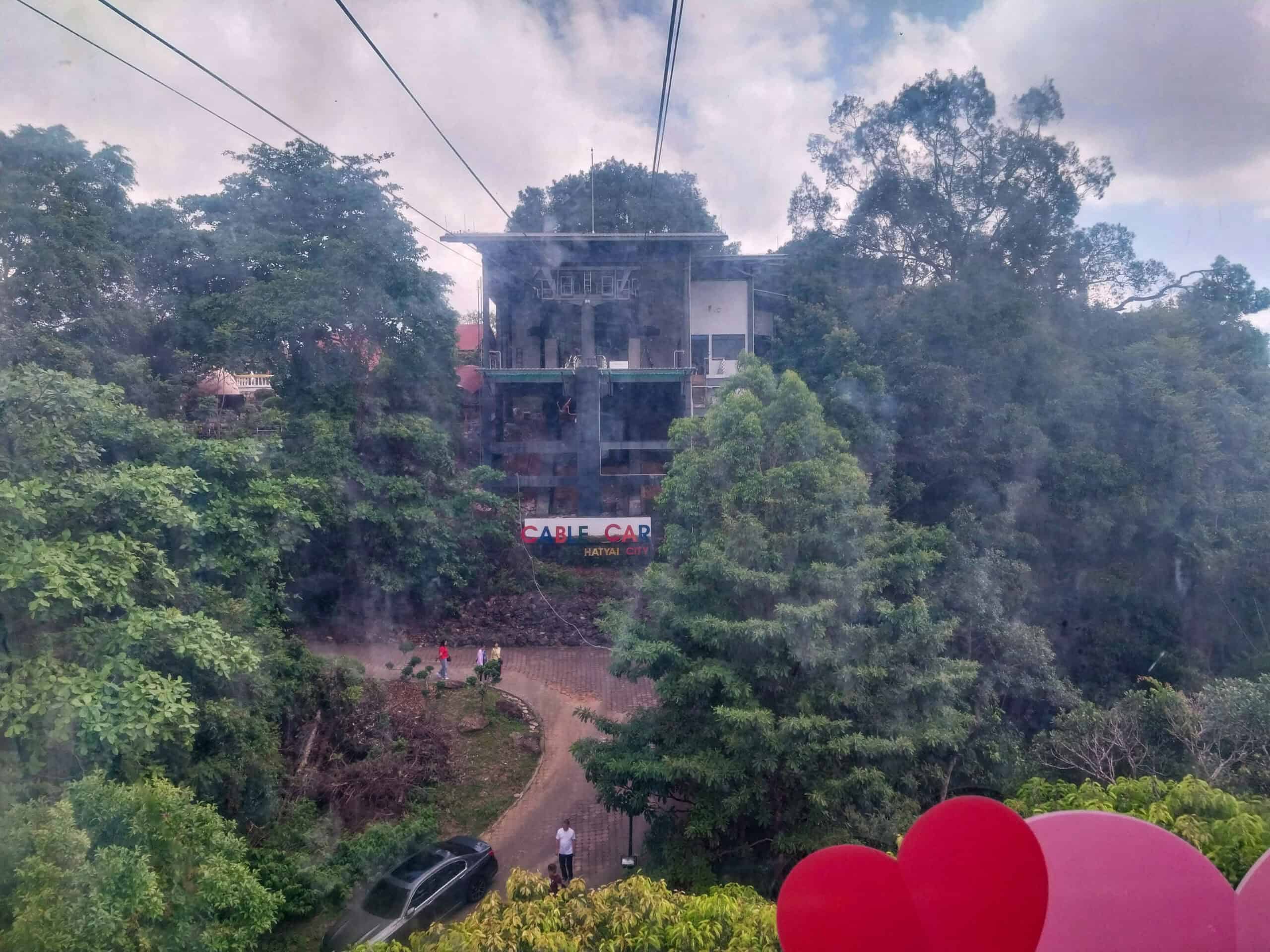
The Thao Maha Phrom Shrine may not be considered a Hat Yai Park must-see by some, but in my personal opinion, it is. In fact, I recommend starting your park exploration with this location, as it’s basically one shrine but offers (literally) a lot of bang for the buck in cultural experience and exotic visuals.
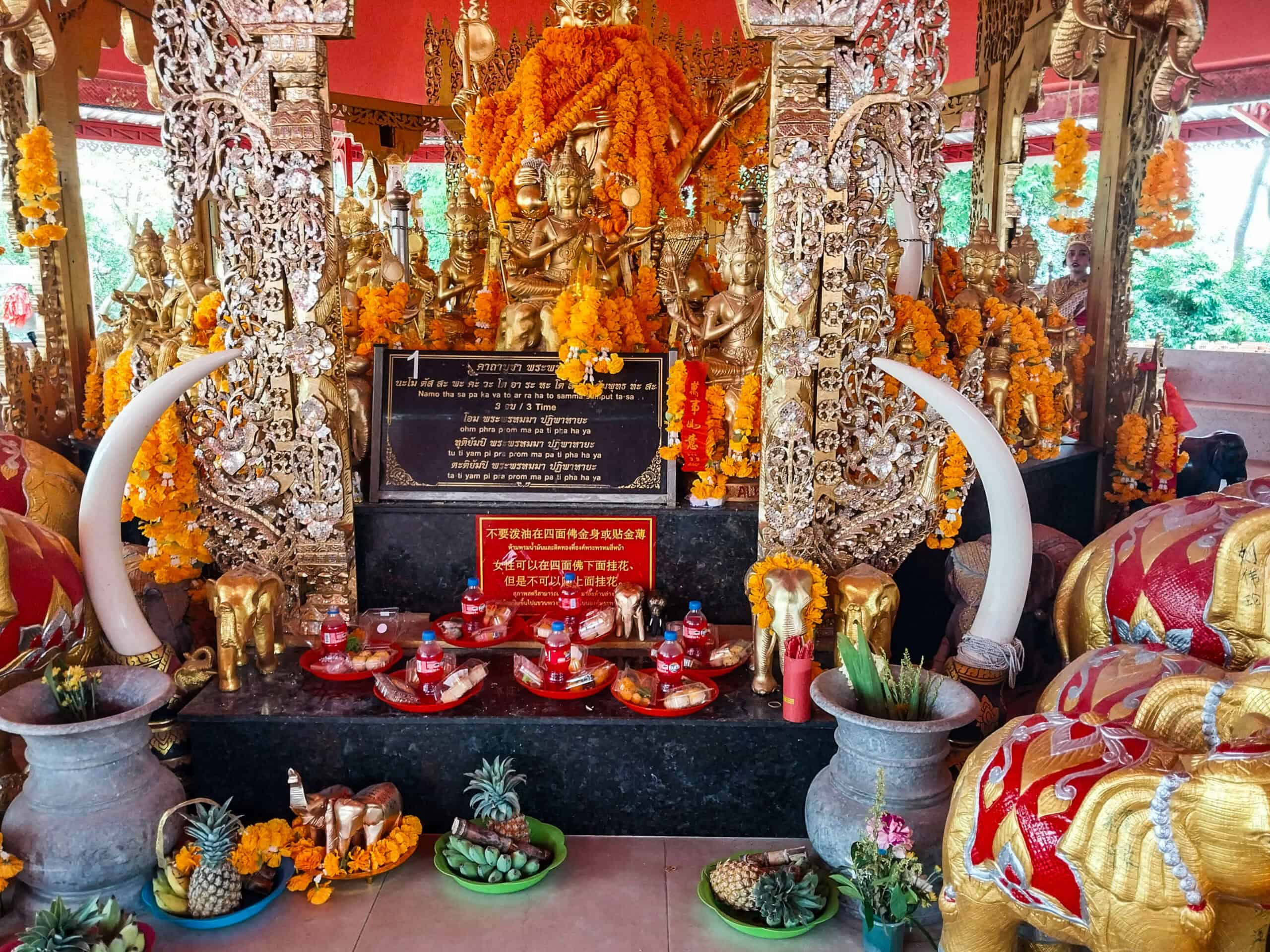
After years of scratching my own head about firecrackers and shrines, I recently learned that firecrackers are used at some shrines as offerings to the deities or guardian spirits to show respect, give thanks, or ask for blessings. The louder, the better! The loud noise is also believed to ward off evil spirits and bring good luck.
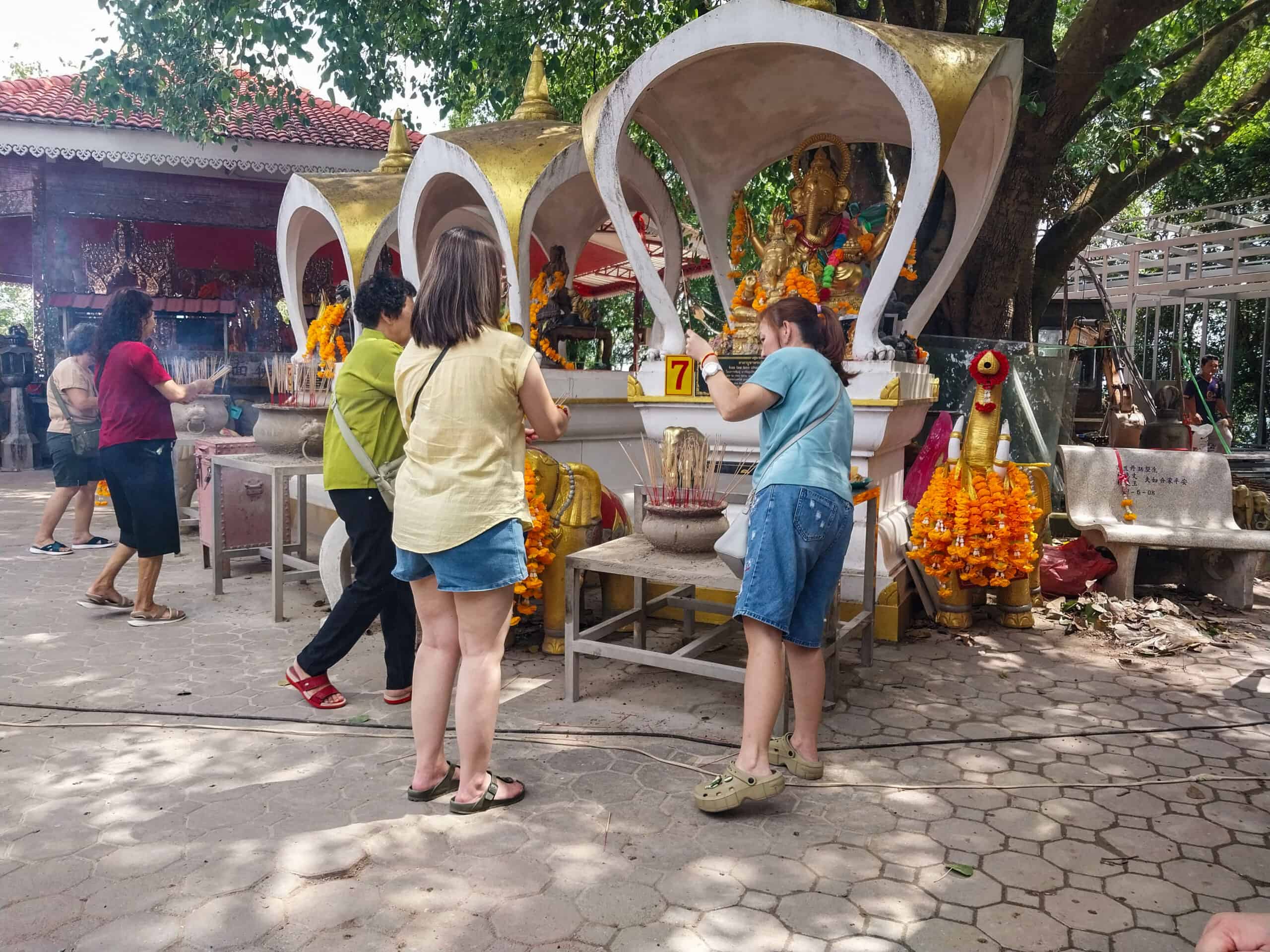
At the Thao Maha Phrom Shrine, visitors can purchase strings of firecrackers for about 1 baht per firecracker, for example, 400 baht for 400 firecrackers. Staff then hang your string of firecrackers in an open box away from people and light them. The sound is deafening but quick and then a number printed on a piece of cloth is the only thing left.
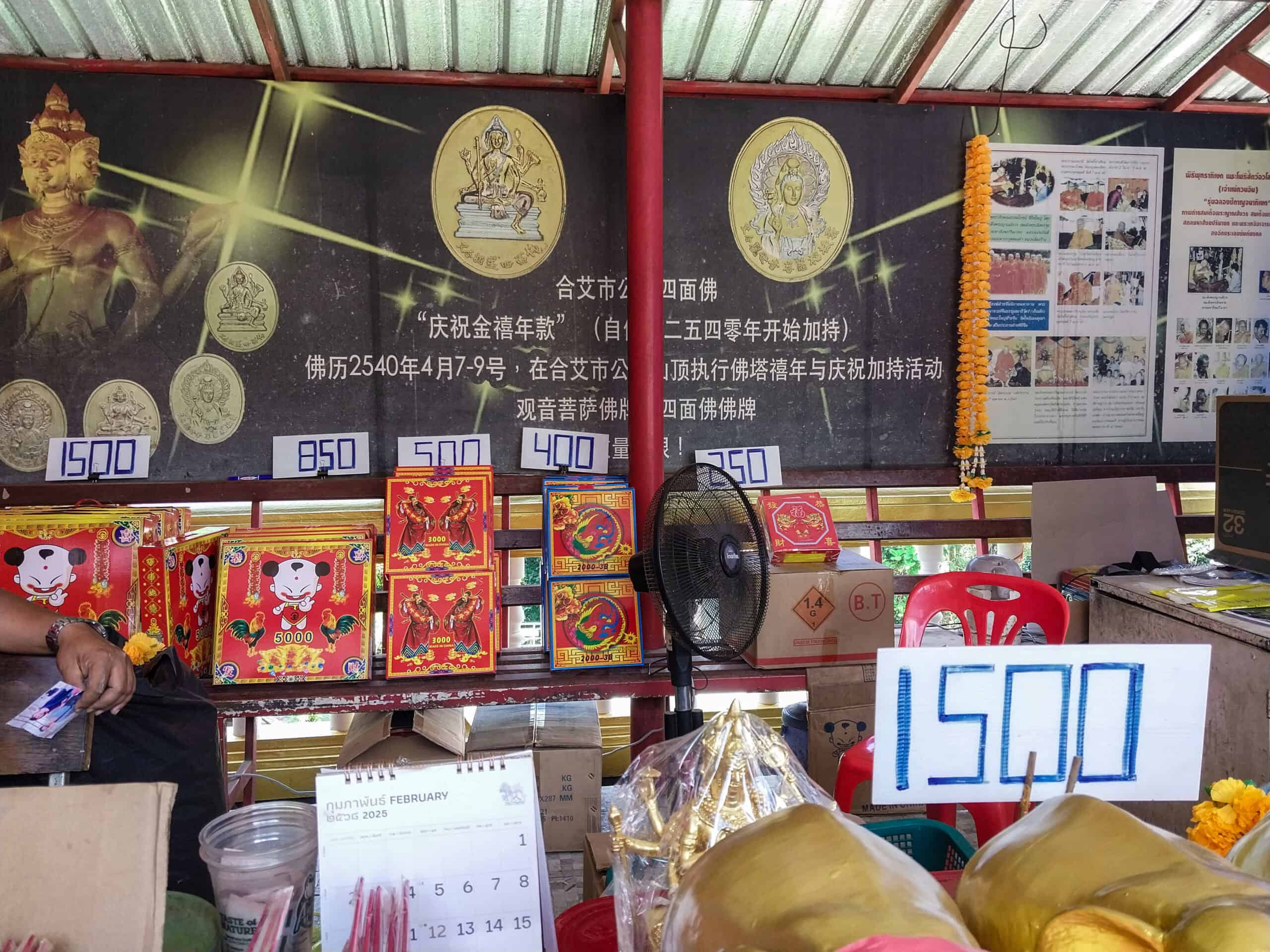
You take your number and step into the shrine and choose an elephant (of which there are many) and then make a wish, ask for a blessing, etc. And then you place the number inside your chosen elephant’s trunk. For the religious as well as non-religious, it’s meaningful.
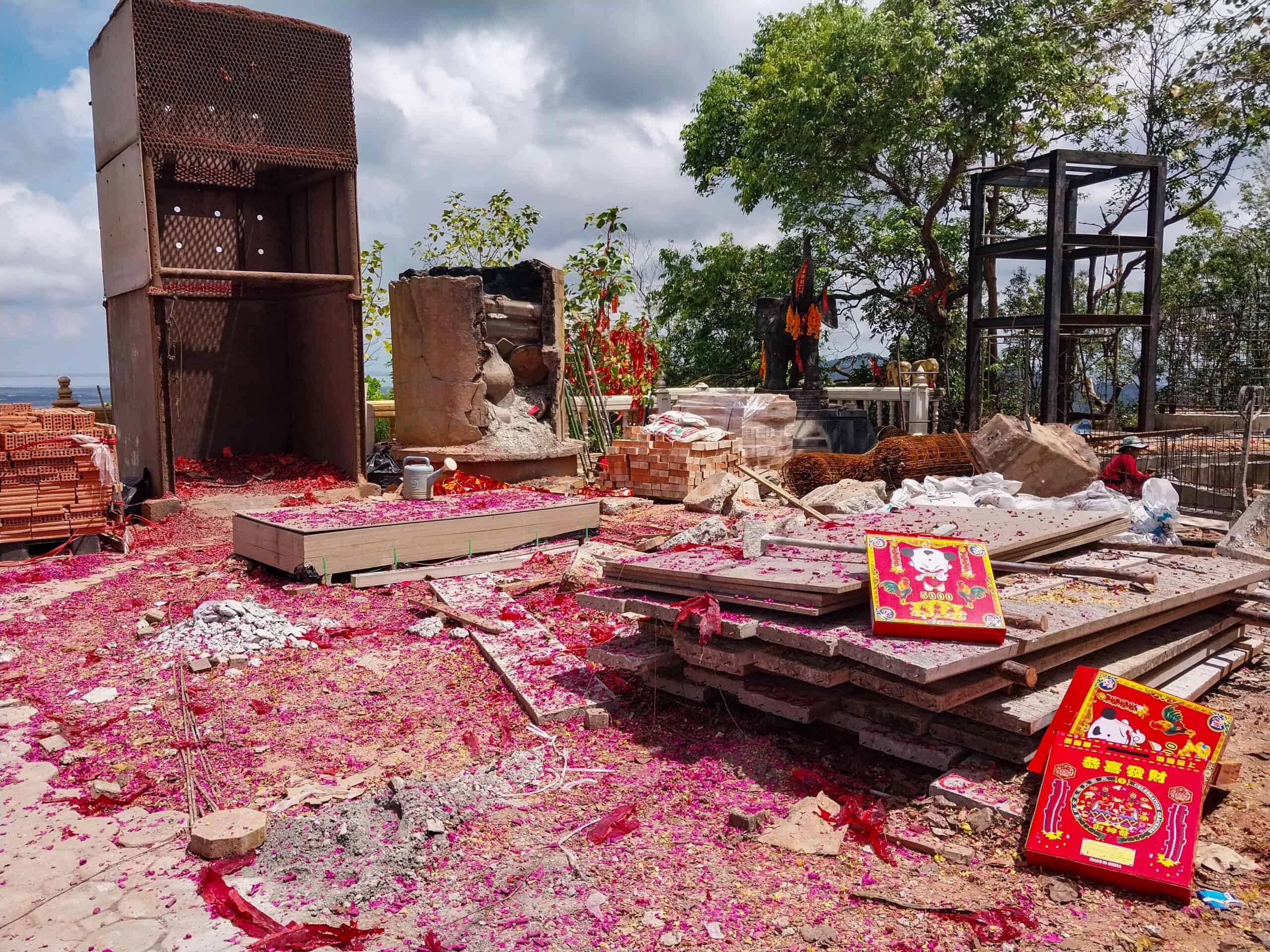
If you take the cable car up to the Thao Maha Phrom Shrine, the ride ends right next to the shrine. After your shrine experience, you can hop back on the cable car and head back over to the Golden Buddha Hill and all that it offers. It’s quick and easy and saves a lot of time.
Next Stop: Guan Yin (Goddess of Mercy)
After you’ve conquered Thao Maha Phrom Shrine and the multiple must-see and dos at Golden Buddha Hill, there is one more stop you need to make before heading back to the lower-level park entrance. That is the blindingly white Guan Yin (Goddess of Mercy). You’ll need to walk down a steep set of stairs or take the main road if you prefer an easier descent. It’s not far, just a short five-to-ten-minute walk.
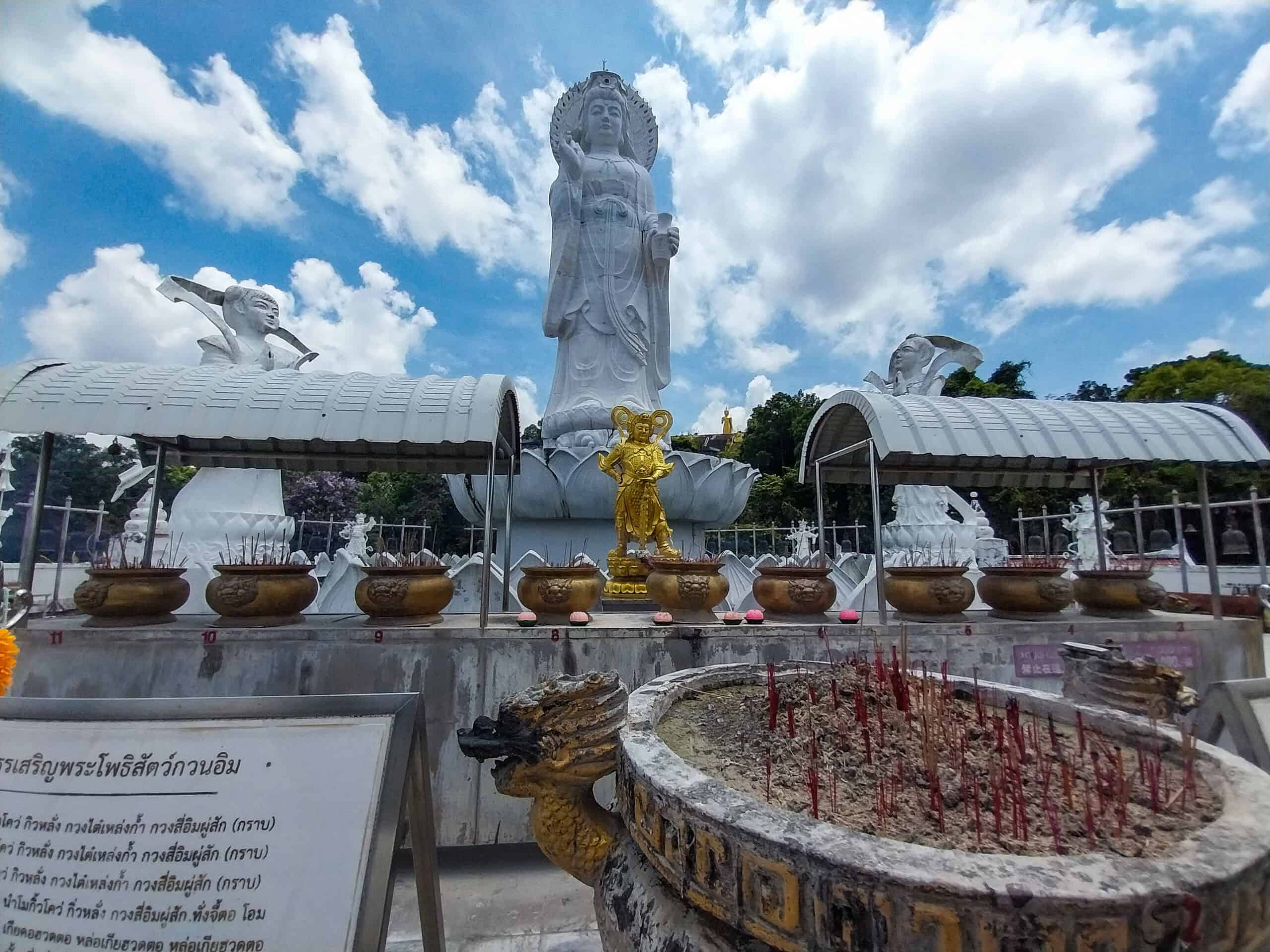
The statue was built in the late 1980s to early 1990s as part of Hat Yai’s plan to turn the hillside into a spiritual and recreational landmark reflecting the city’s strong Thai-Chinese heritage. The Golden Standing Buddha represents Thai Buddhism above, and Guan Yin symbolizes Chinese Mahāyāna devotion below.
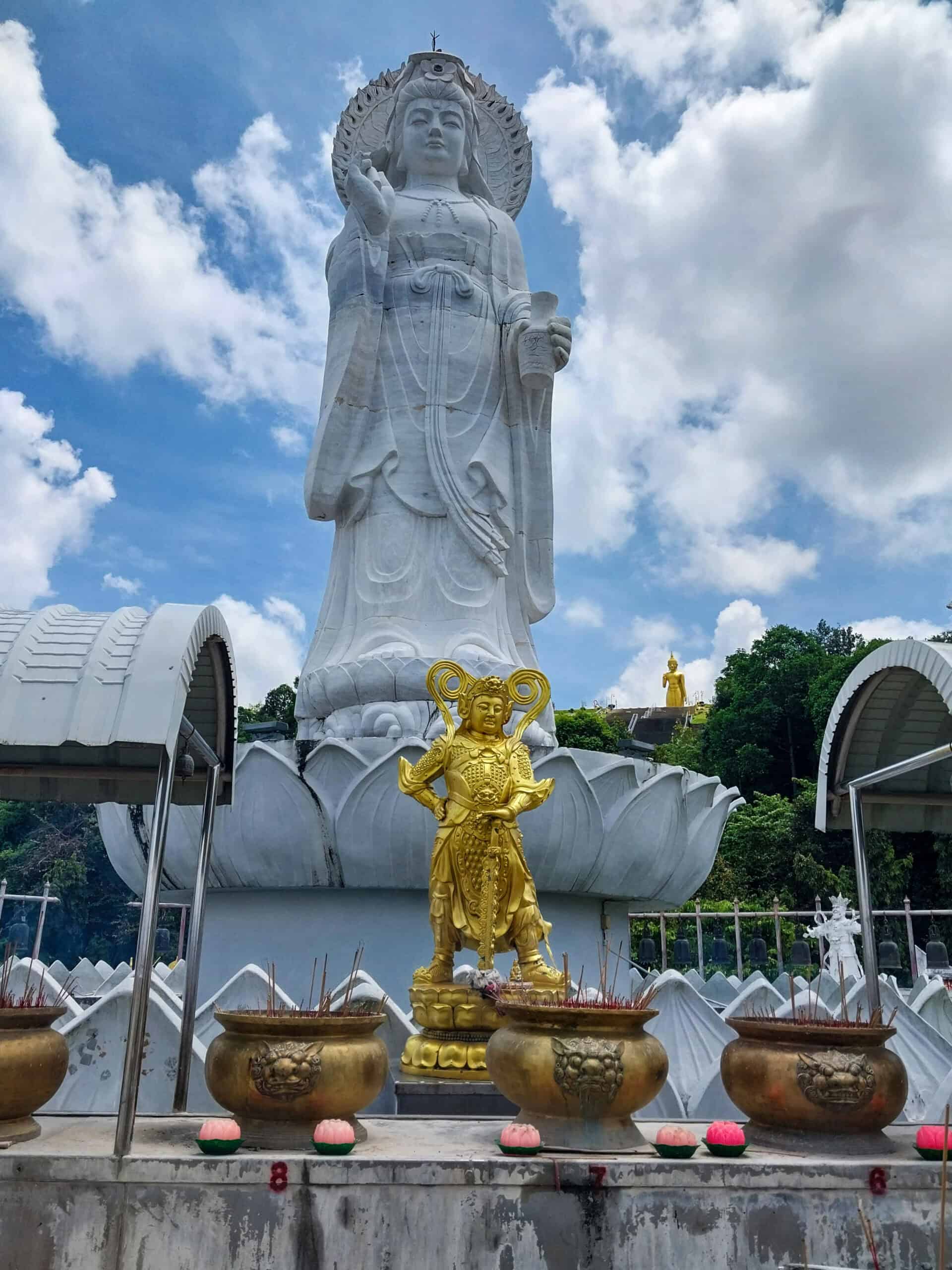
She was donated by local Chinese-Thai devotees and Buddhist groups from Songkhla and Penang. Carved from smooth white marble in a Southern Chinese temple style, her design features pillars, dragon motifs, and lotus details. Artisans from China oversaw the installation to ensure her posture and hand gestures were just right.
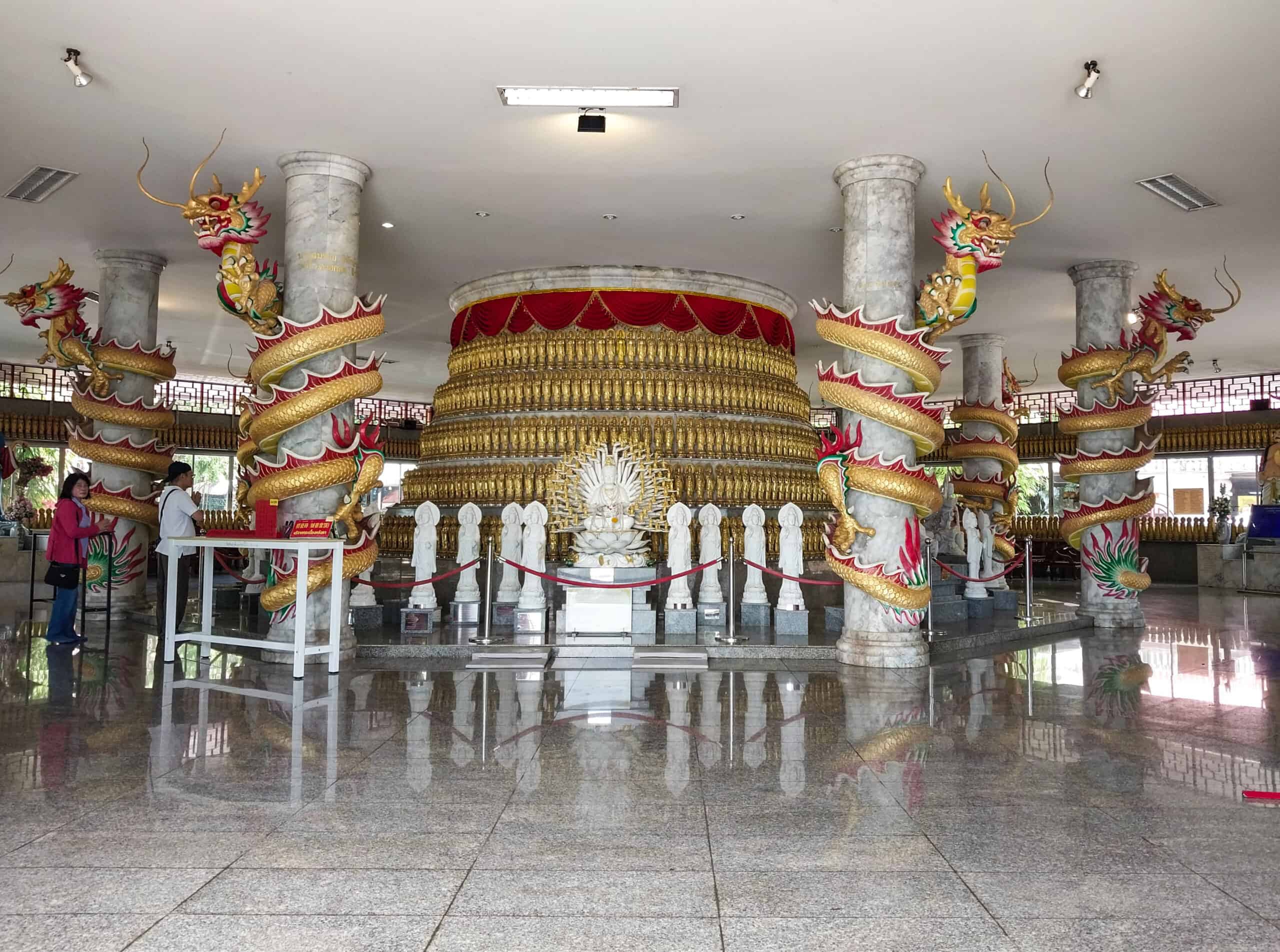
After opening to the public, the shrine quickly became a place of prayer for health, safe travels, and blessings. Today, the White Marble Guan Yin watches over the city from her peaceful terrace. A calm counterpart to the tourist hot spot Golden Buddha Hill above. From certain vantage points both the Guan Yin and Golden Standing Buddha can be photographed together.
Final Stop: Lakeside Area (Main Entry of the Park)
That’s a wrap! Almost. After your Guan Yin visit, it’s time to head downhill again. You can sit around and wait for a ride to magically appear, or you can just start walking. If you’re not part of a large group, there’s about an 80% chance someone will offer you a ride. It may help to stick out your thumb a bit to indicate that you’d appreciate one too. Don’t be picky either. If it’s a dirty park maintenance truck, so be it. At least it saves you time, and that’s always a good thing.
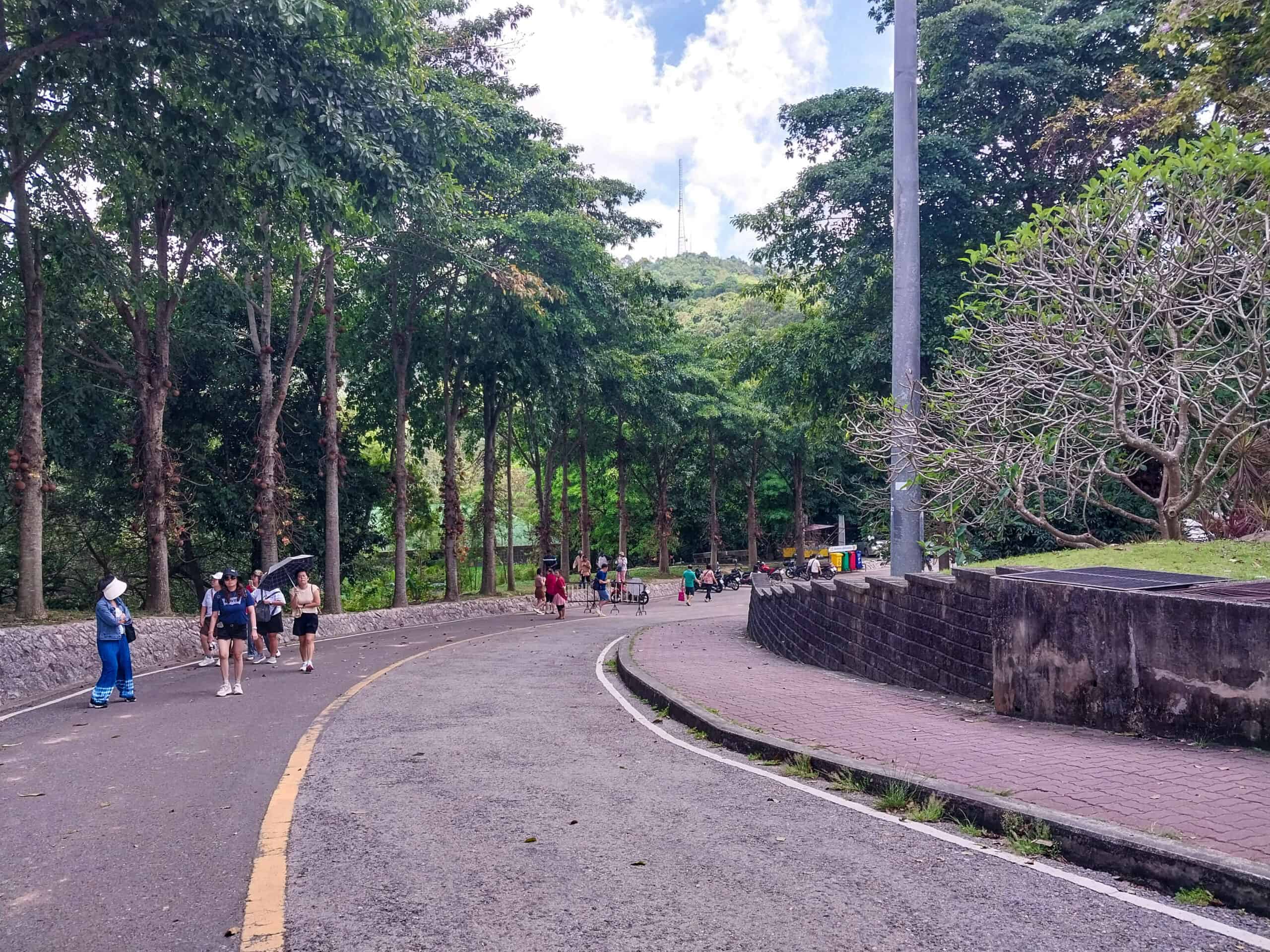
At the foot of Khao Kho Hong is the park’s main entrance area. It’s a shady recreational space that’s popular with families, joggers, picnickers, and anyone looking for a quiet walk. This is usually the first section visitors pass through before heading uphill.
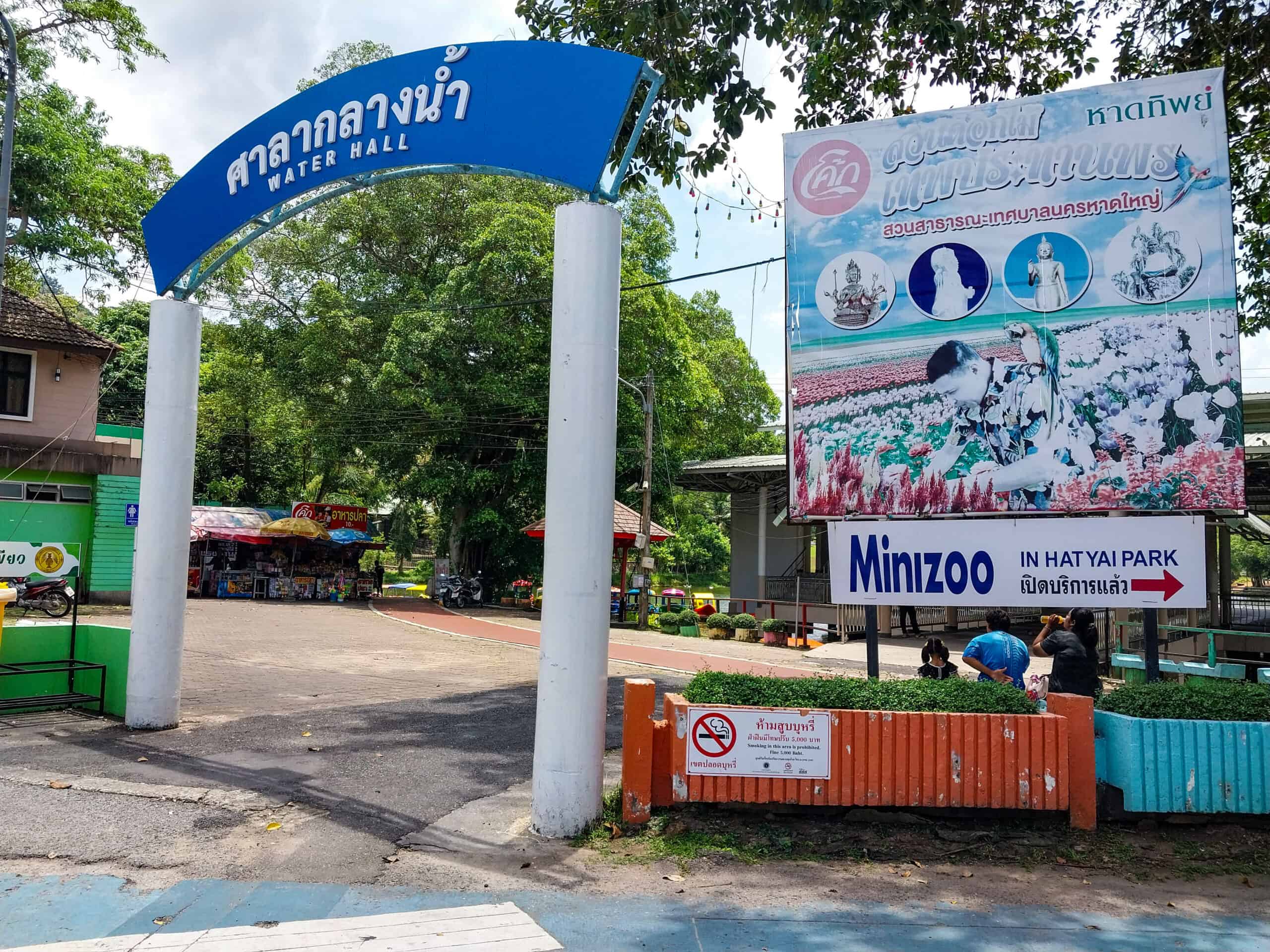
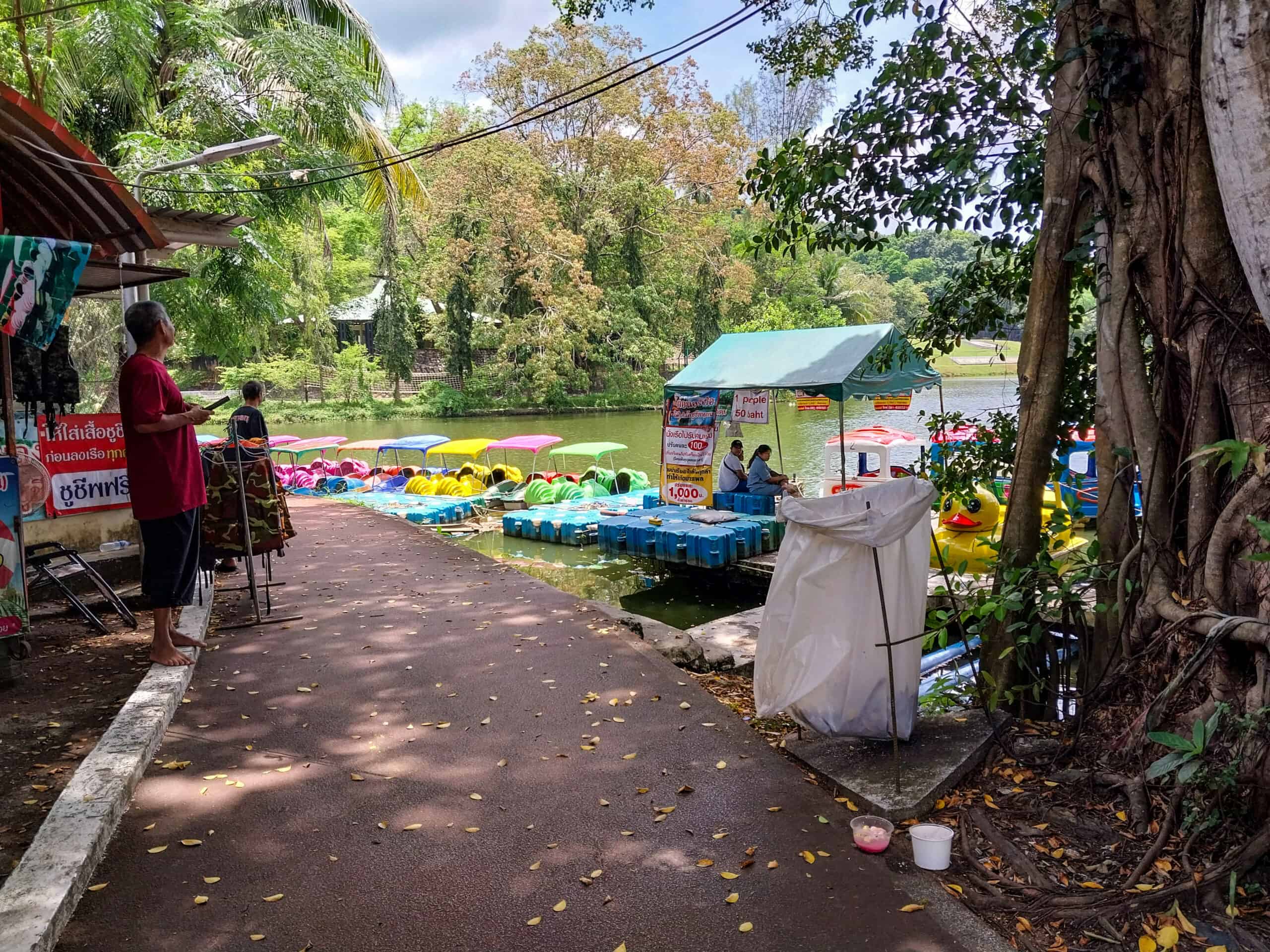
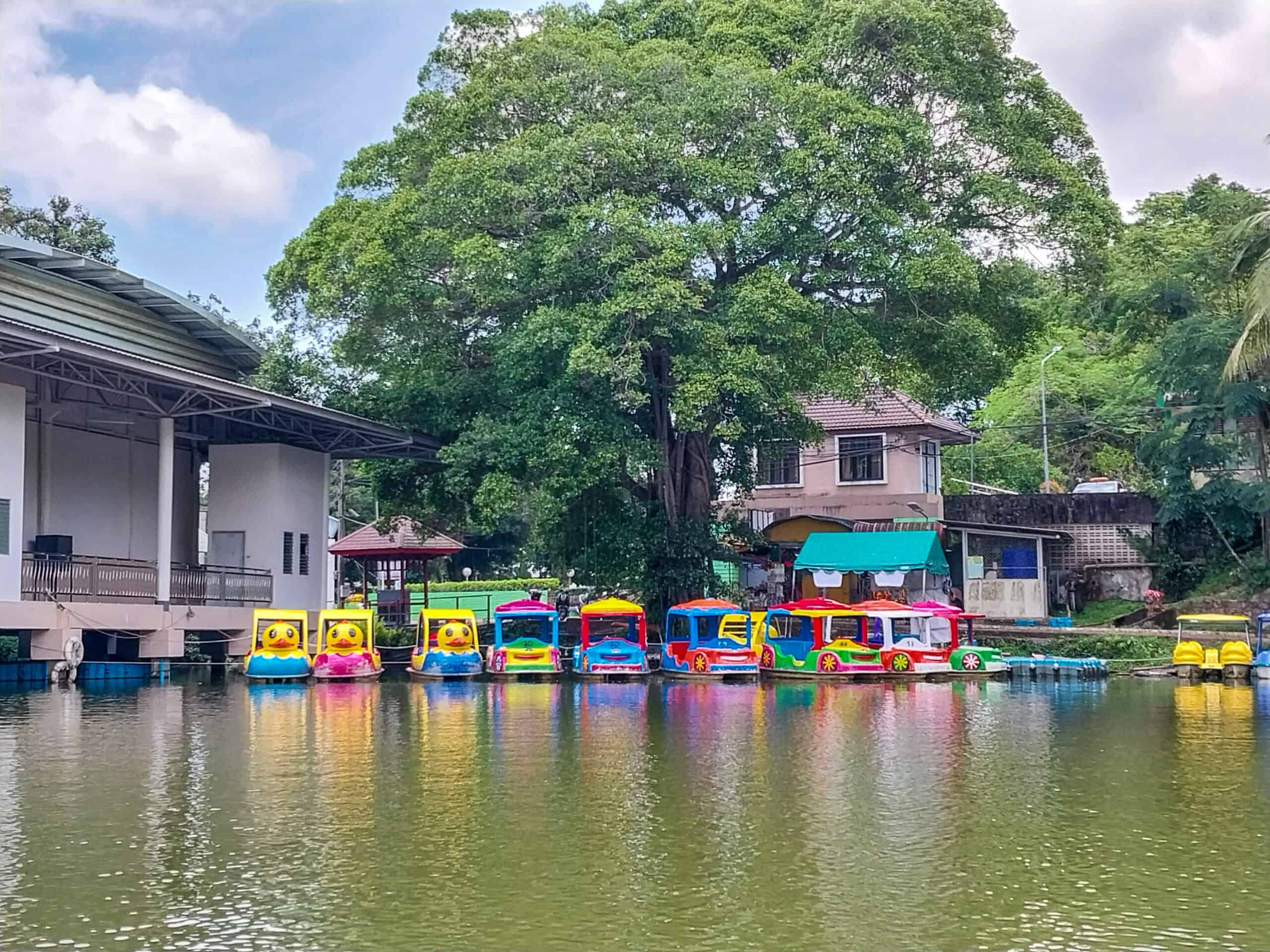
Here you’ll find a large lake with colorful pedal boats for rent. There’s also a suspension bridge, open lawns, and a small playground. It’s the most relaxing area of Hat Yai Park and a good spot to unwind after exploring the hills above.

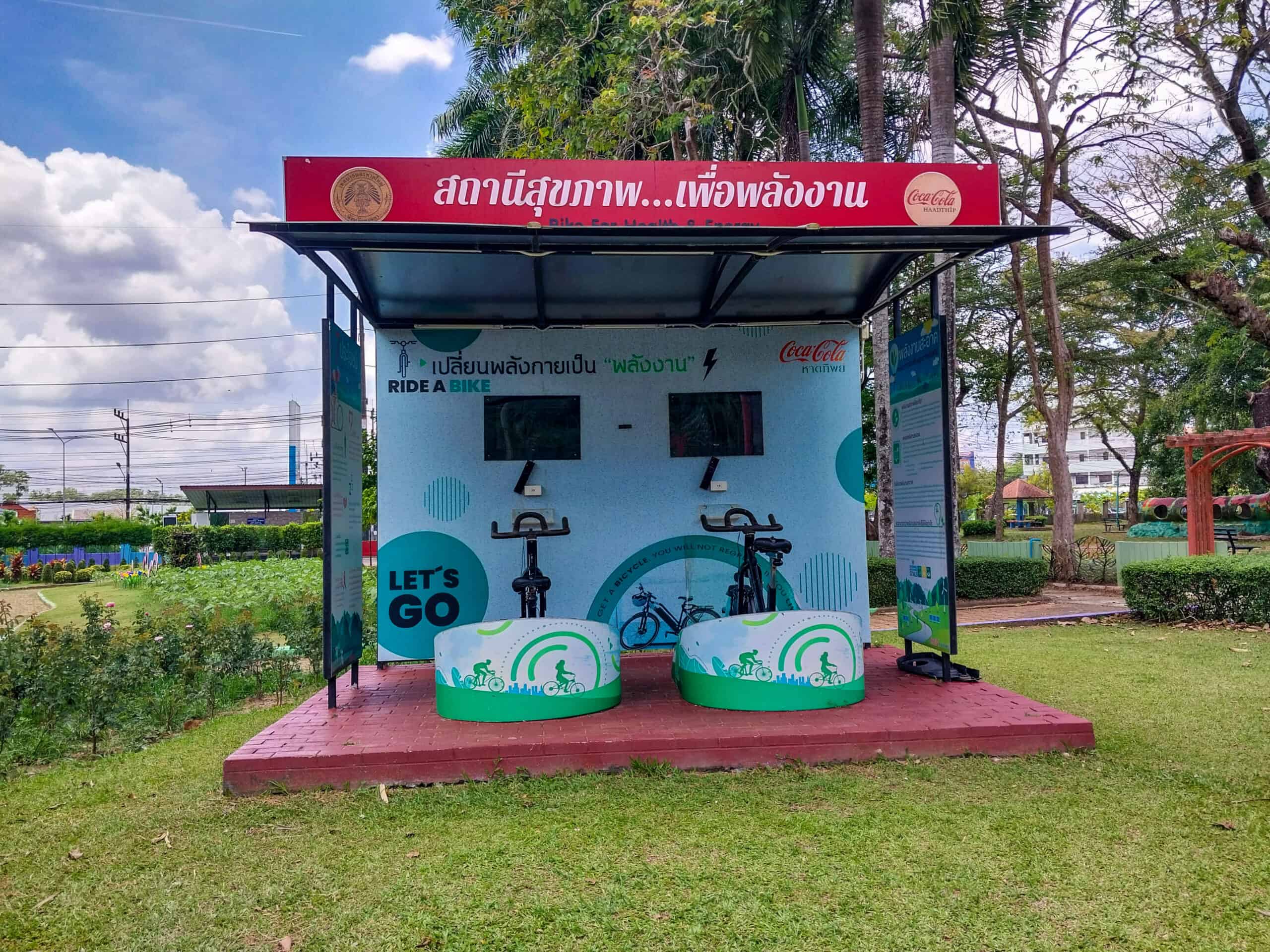
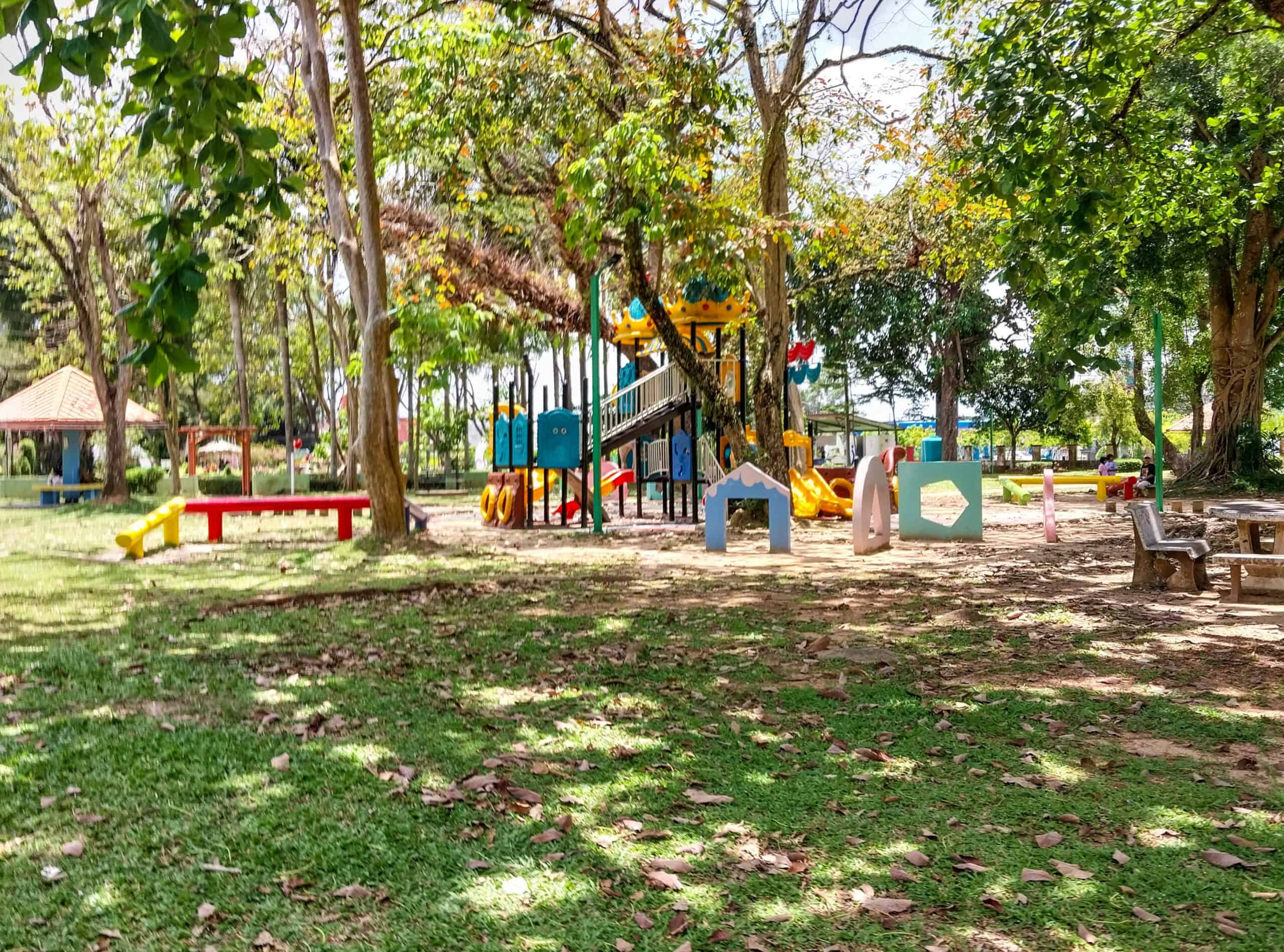
By the way, the whimsical pedal boats at Hat Yai Park’s lake aren’t just for kids. These retro-style, foot-powered boats are great for cruising around the lake and are rentable for just 50 baht. There’s also no strict time limit on use (within reason). It’s a great way to wrap up a visit to picturesque Hat Yai Municipal Park. The boats are located at the lake near Gate 3, at the front of the park near the Mini Zoo.
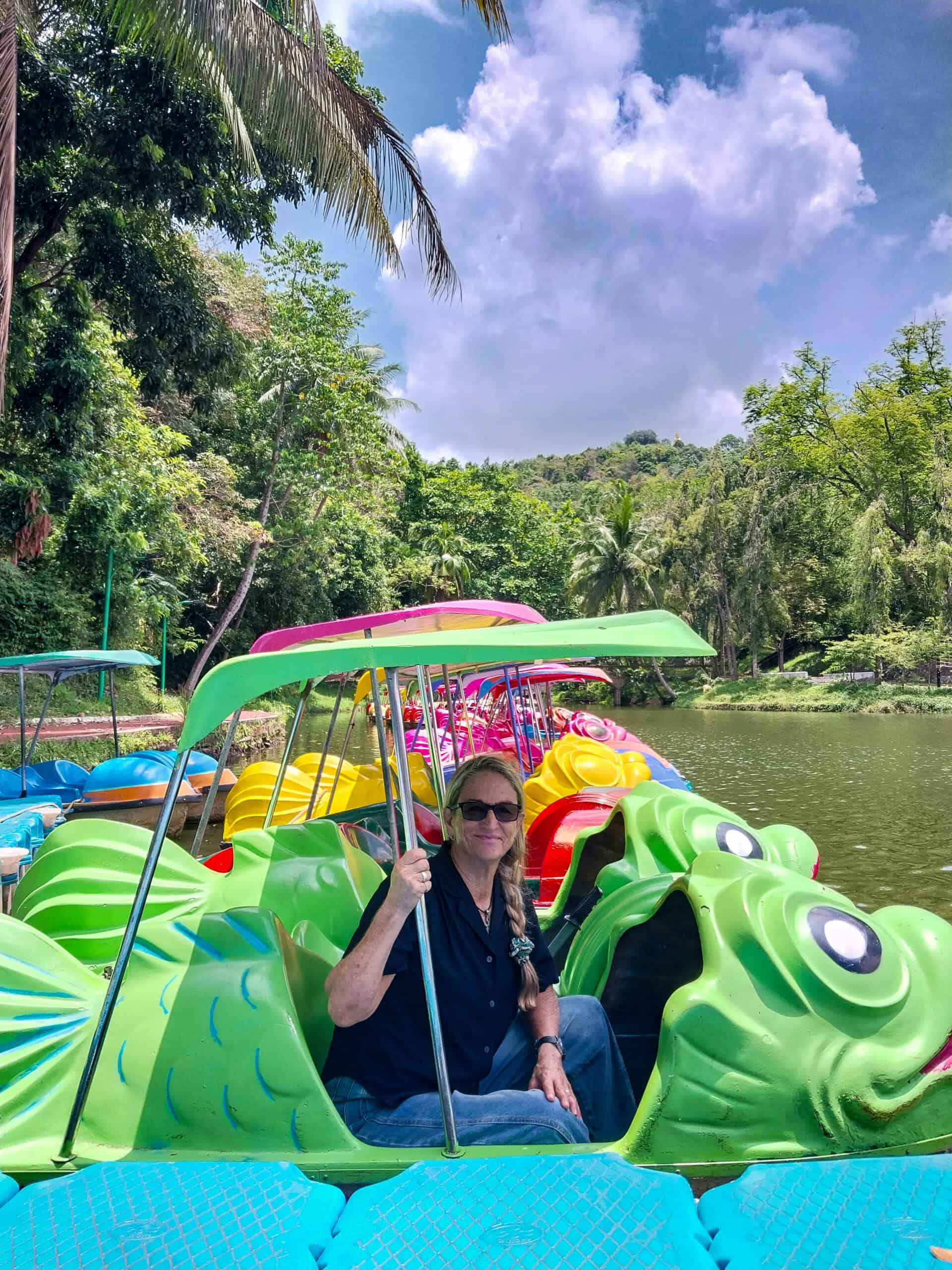
Getting to (and from) Hat Yai Municipal Park
Like I said previously, taking a Grab taxi to Hat Yai Park is the fastest and most convenient option. If the driver tries to let you out at the park entry, renegotiate (with a friendly smile). Ask to get dropped off at Phra Buddha Mongkol Maharaj or the Hat Yai Cable Car instead. Make sure the cable car is open before you get out.
If its closed, ask the driver to head up to Thao Maha Phrom Shrine for your final drop-off. Giving a nice tip at this point will make it easier for future visitors to get the same consideration.
When you’re ready to head back to Hat Yai city center, go out through Gate 3. You’ll find a songthaew stop just outside the gate. You can choose to take the next songthaew back into town, or call a GRAB. The Grab taxi app actually specifies a Gate 3 pickup location, which happily eliminates any confusion.
Pro Tip:
Bring sunscreen, water, and a hat. There’s plenty of shade around the shrines, but it still gets hot, especially midday. A rain poncho or an umbrella can be handy. Especially, if you’re visiting during rainy season (May–December, with heaviest rain from September to November). Comfortable shoes are a must for walking between hilltops. You’ll thank yourself later.
Hat Yai Municipal Park
Kanjanavanich Road
+66 74 211 898
Open daily: 5:00am until 8:30pm
Entry: free

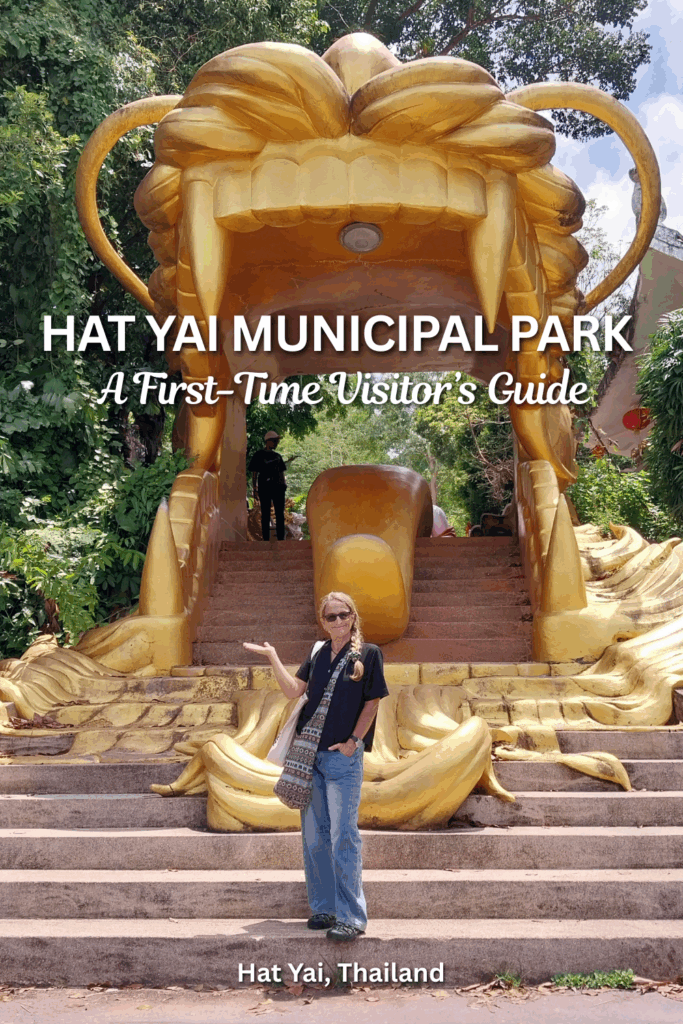
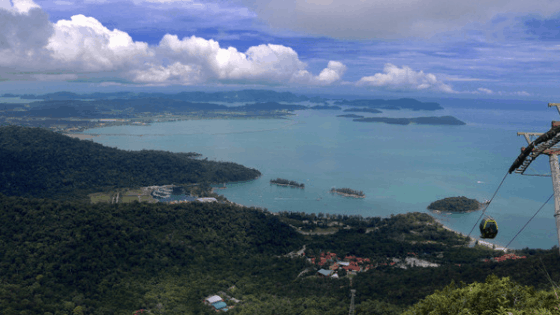
Leave a Reply